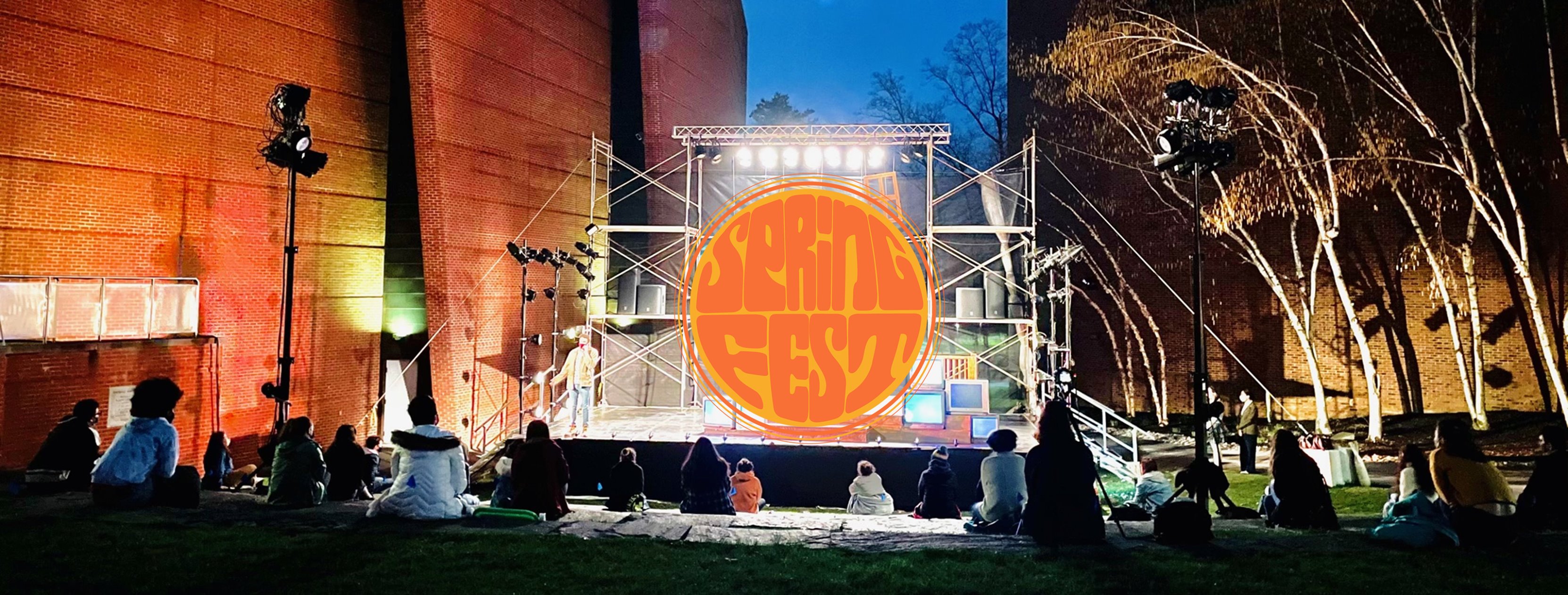Co-Edited by Eliza Kuperschmid ‘21 and Gemma Siegler ‘22
The second weekend of SpringFest was also a huge success and was just another reminder of the resilience of the festival and its participants. Despite freezing tech-week temperatures, rainy weather, and the always-present challenges of the Pandemic, the Weekend Two productions soared.
With fifteen different performances happening throughout SpringFest, STLN thought that the best mode of reporting would be “Weekend Wrap-Ups,” one article per weekend containing everything you need to know about what happened on the SpringFest stages. Hopefully, the joy of the SpringFest audience members can be felt through our staff writers’ brief summaries of each weekend two performance below!
___
Uplift
Covered by Eliza Kuperschmid ‘21
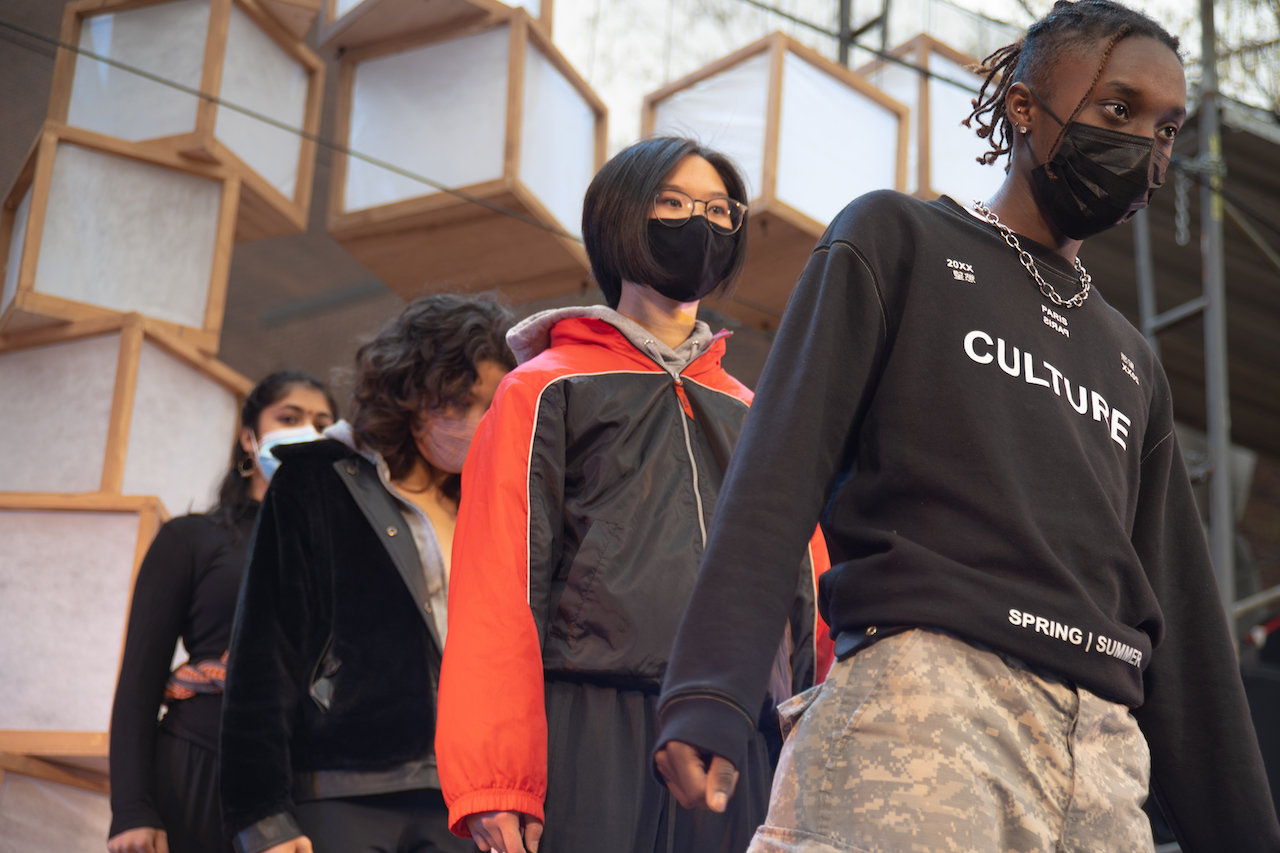
Photo by Coltrane Cho ’24
Uplift, conceptualized and directed by Will Carter ‘23 and Anne-Sophie Vandenberk ‘23, was a necessary and long overdue showcase and uplift of BIPOC voices on stage in a Skidmore College Theater production. Though the performance was raw and unfiltered, the energy of the space was filled with love and light. This was especially clear in the moments immediately after the show ended when the entire cast and crew screamed with joy and embraced in a group hug; you could tell how invigorating it was to have performed this piece.
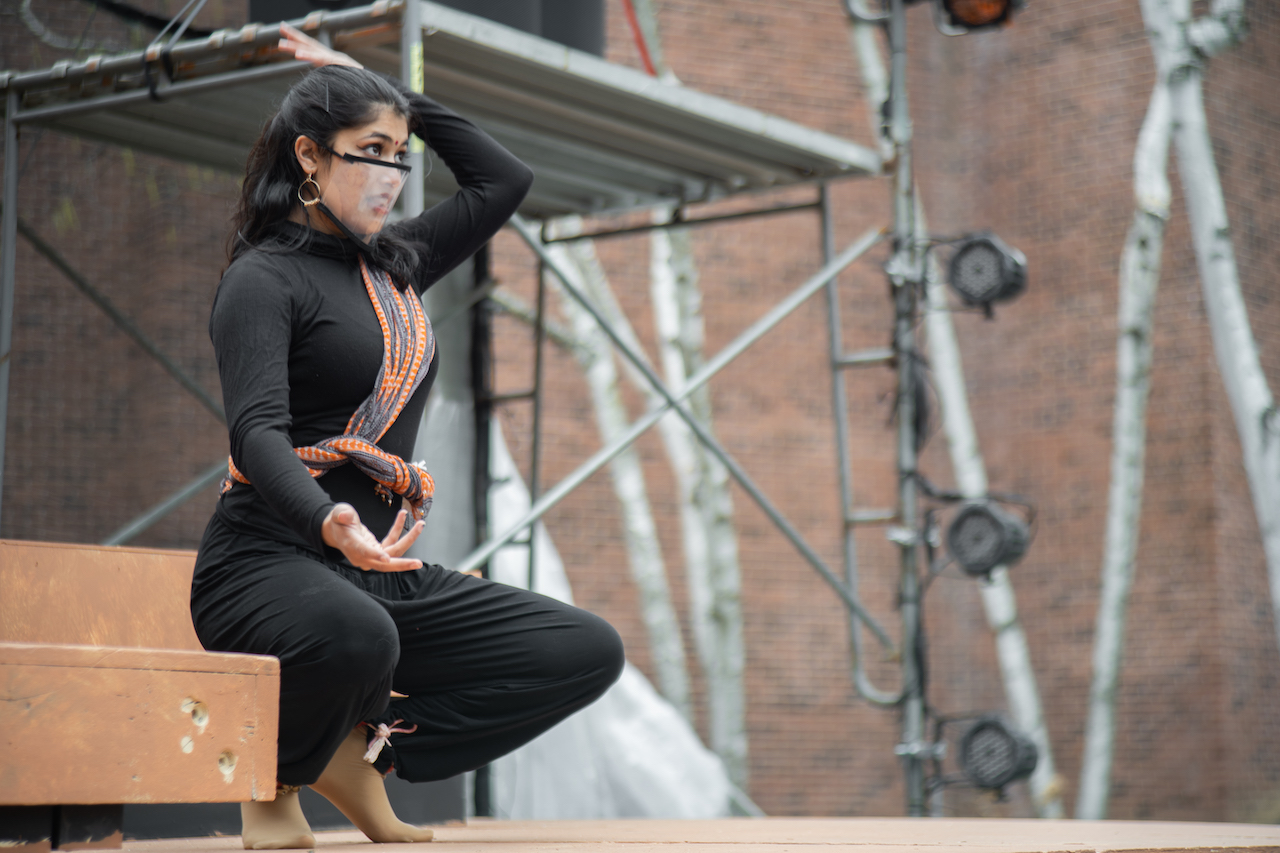
Photo by Coltrane Cho ’24
Each cast member had a moment to showcase their individual talents in the Uplift space. The piece opened with Sarita Padukone ‘23 alone on stage. She wore bells around her ankles and danced. Sarita was wearing a clear face mask so the audience was able to see her glistening smile as she moved and danced around the space to “Thillana 2.0” by Dhanashree (feat. Sharanya Srinivas). Then Isha Smith-Ramakrishnan ‘22 entered and shared an intimate moment with the audience as she strummed her ukelele and played an original song with the utmost passion and skill, her flawless vocal runs gliding in the wind that swirled around the Thomas Amphitheater. Jacob Smith ‘24 delivered a powerful spoken word address and made deliberate and direct eye contact with the audience as he shedded seemingly infinite layers of Hawaiian shirts on stage. Anesu Mukombiwa ‘24 combined spoken word address with a haunting a capella song as she faced the audience and spoke into a microphone. Isabella Kiely ‘24 recited a soul-bearing monologue that told the story of her dual-ancestry and the internal conflict she feels because of it.
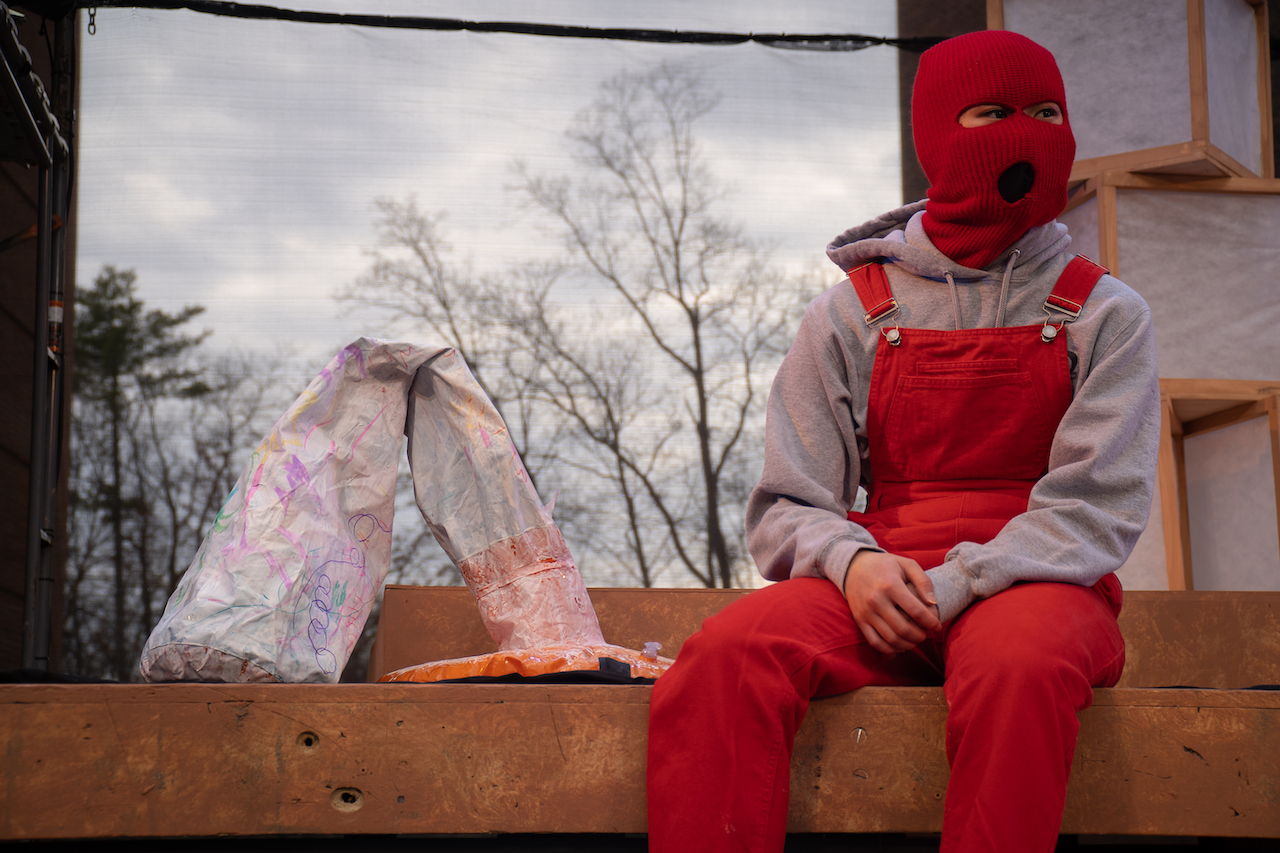
Photo by Coltrane Cho ’24
Annalise Sawit ‘21 performed as her alter-ego “Red,” a persona that is explained in the Uplift program as: “Everyone has aspects about themselves they feel like they could never share with others. Red is the manifestation of that. Red allows for thoughts, actions, and sentiments that build up and yearn to be released — for better or for worse.” Red wears red overalls and a ski mask. They use markers and colored paper shapes to decorate a white, inflatable punching bag. Red becomes frustrated with the punching bag and begins to taunt it, wordlessly beckoning it to fight. Red enters once again with a hefty stick and begins to violently attack the punching bag before collapsing on the floor of the stage.
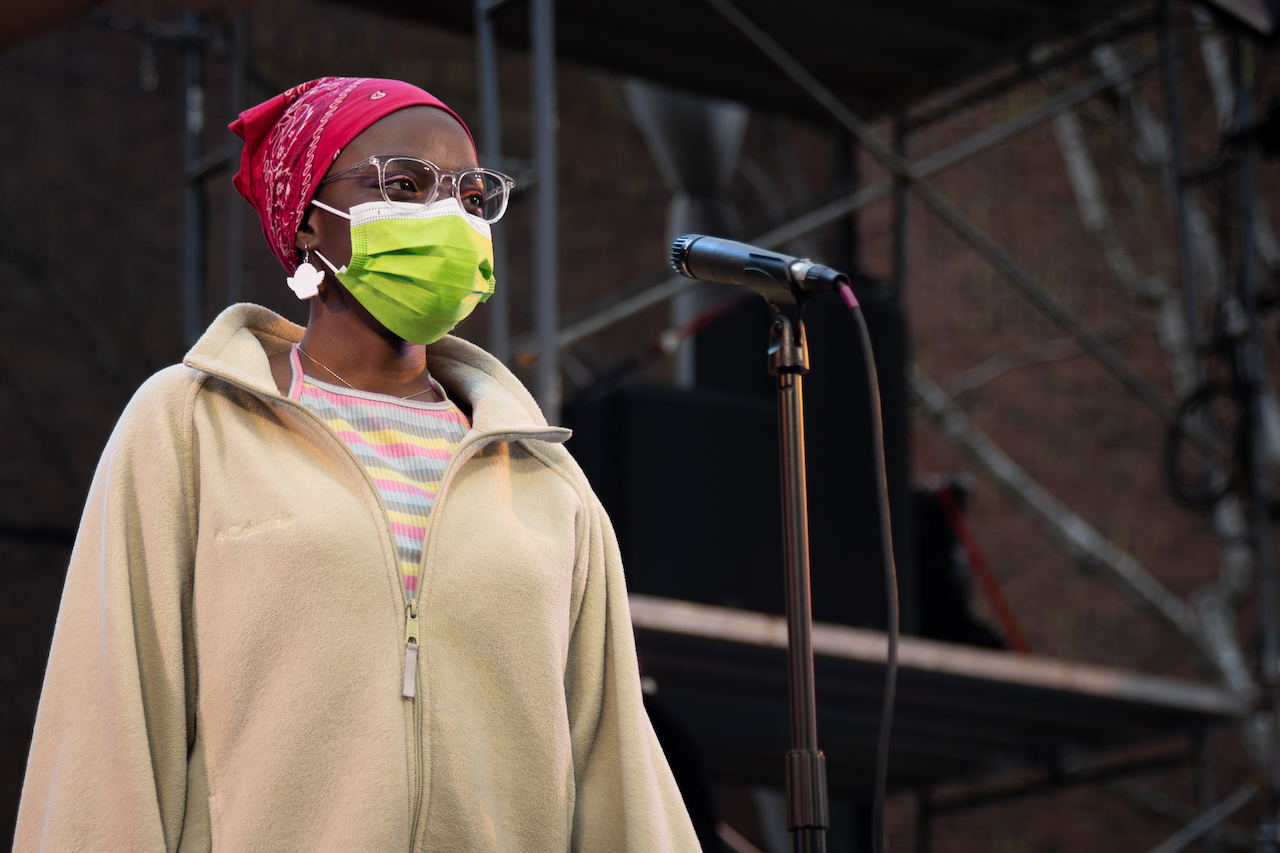
Photo by Coltrane Cho ’24
The cast also shared group numbers together. They took turns reciting the same spoken word address, speaking some of the lines in unison, and dancing together as Anesu sung a cappella. One of the most memorable moments of the show was the largest group number. The entire cast emerged with Skidmore signs and sarcastically high energy. Each cast member stepped forward and the audience was meant to applaud for “who did it better,” the cast member or an example of how their culture has been appropriated. For example, Arielle Lam ‘24 strutted on stage in a traditional Chinese robe and the audience had to choose whether she wore it better than racist portrayals of Chinese clothing in the media. In this moment, the audience was not just observing the Uplift space but became directly involved in it. This was especially true in the moments immediately after the group number when the cast announced “Dear white Skidmore” and delivered a message straight to the audience.
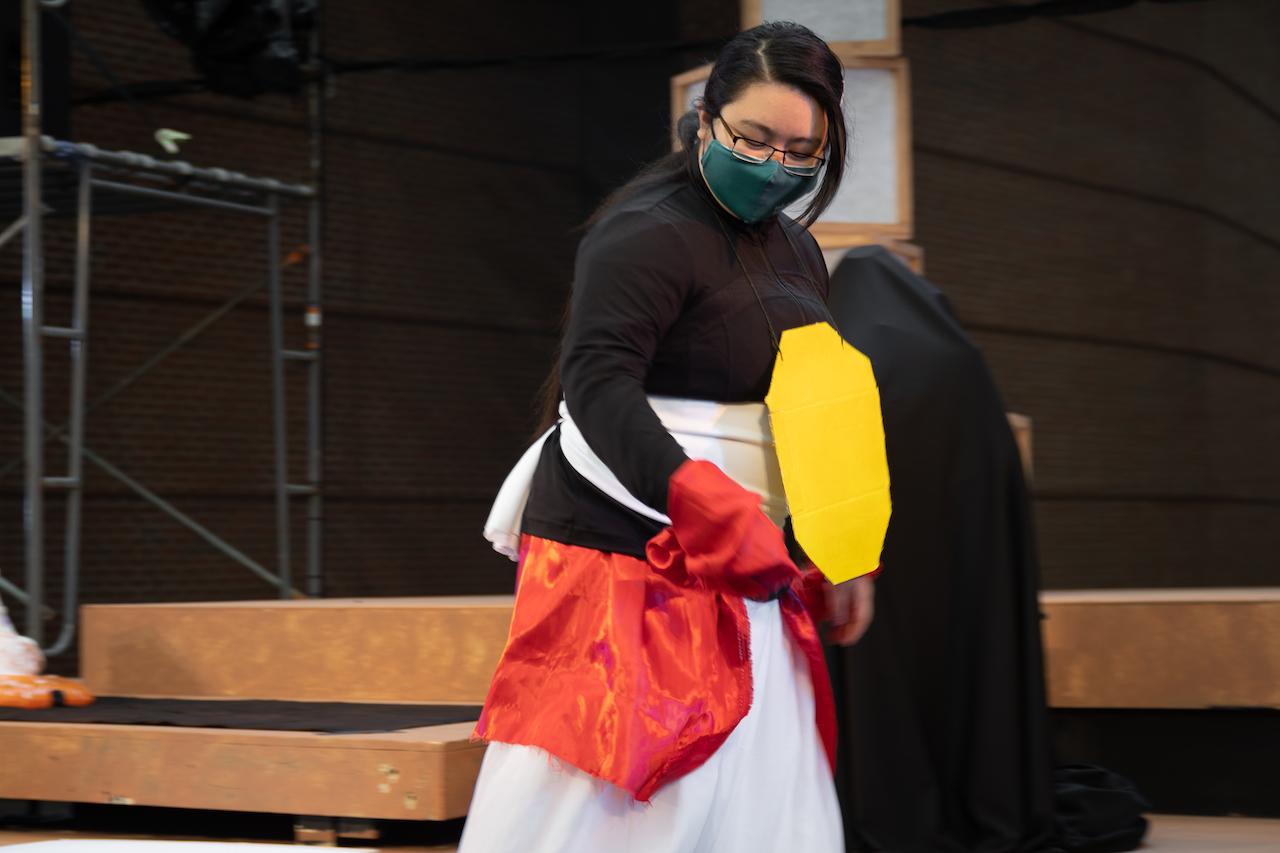
Photo by Coltrane Cho ’24
There were a few very small moments during Uplift that you could miss if you blinked but were extraordinarily moving. After Isha’s song, Jacob laid his jacket on the ground for her to walk over as she exited the stage. This small gesture was a visual representation of how the cast was uplifting one another throughout the performance; while each person had a chance to showcase their talents individually, everyone made sure to support one another. Uplift was raw and vulnerable; everything was left on the stage for the audience to take in.
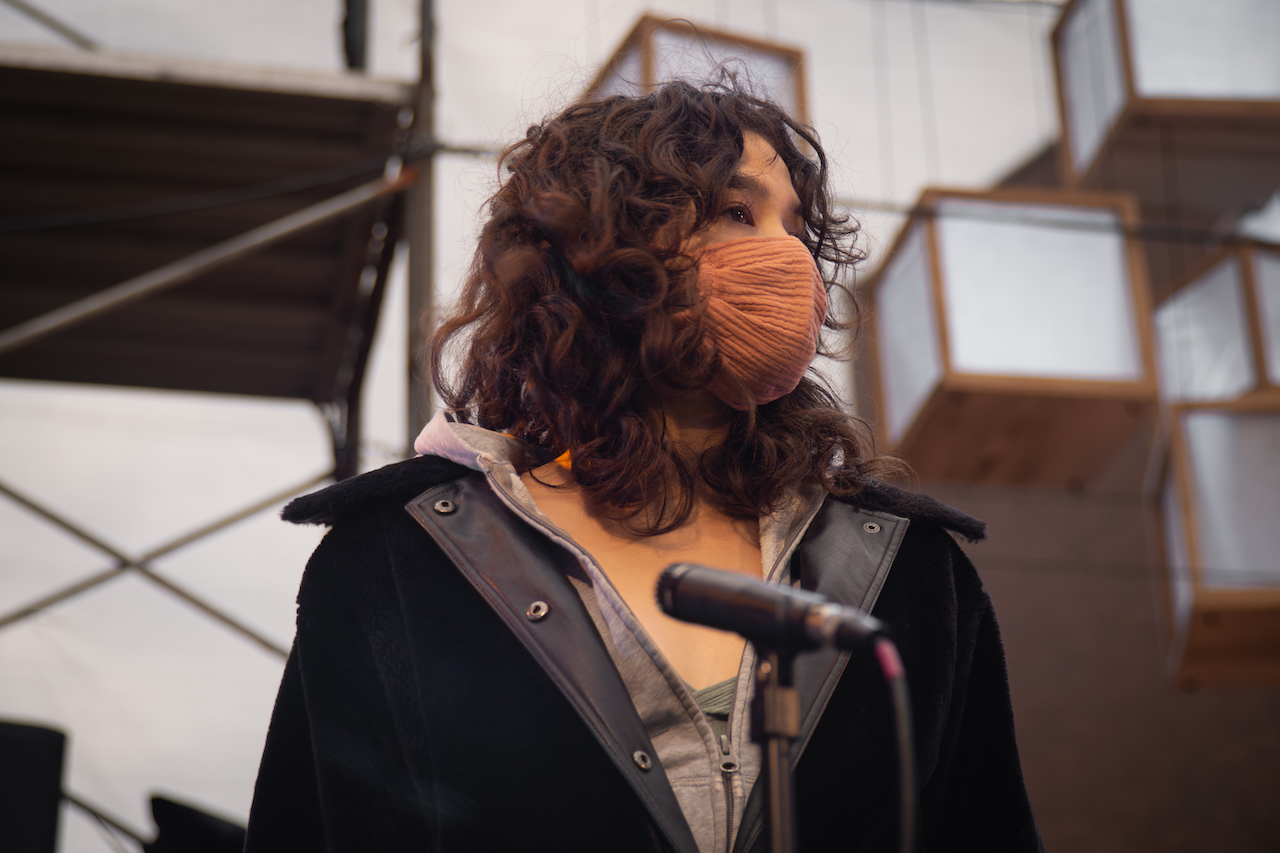
Photo by Coltrane Cho ’24
One of the most momentous facets of Uplift’s weekend of performances was the team’s decision to have a BIPOC Affinity Night for their Saturday evening showing. This meant that only BIPOC students and faculty were able to attend the Saturday evening performance, creating a space of camaraderie support. Though BIPOC students of Skidmore’s past and present have been doing this type of work already, the BIPOC Affinity Night was the first in recent Skidmore Theater history. Skidmore is a predominantly white institution located in Saratoga Spring, New York, a town that, according to the most recent U.S. census, is made up of 89.7% white individuals, 3.69% Asian individuals, 1.95% Black individuals, and 0.119% Indigenous individuals, a category so small that it does not even show up on the census’s pie chart. There are very few, if any at all, spaces for BIPOC individuals on Skidmore’s campus and in the larger Saratoga community. This moment and this space were necessary.
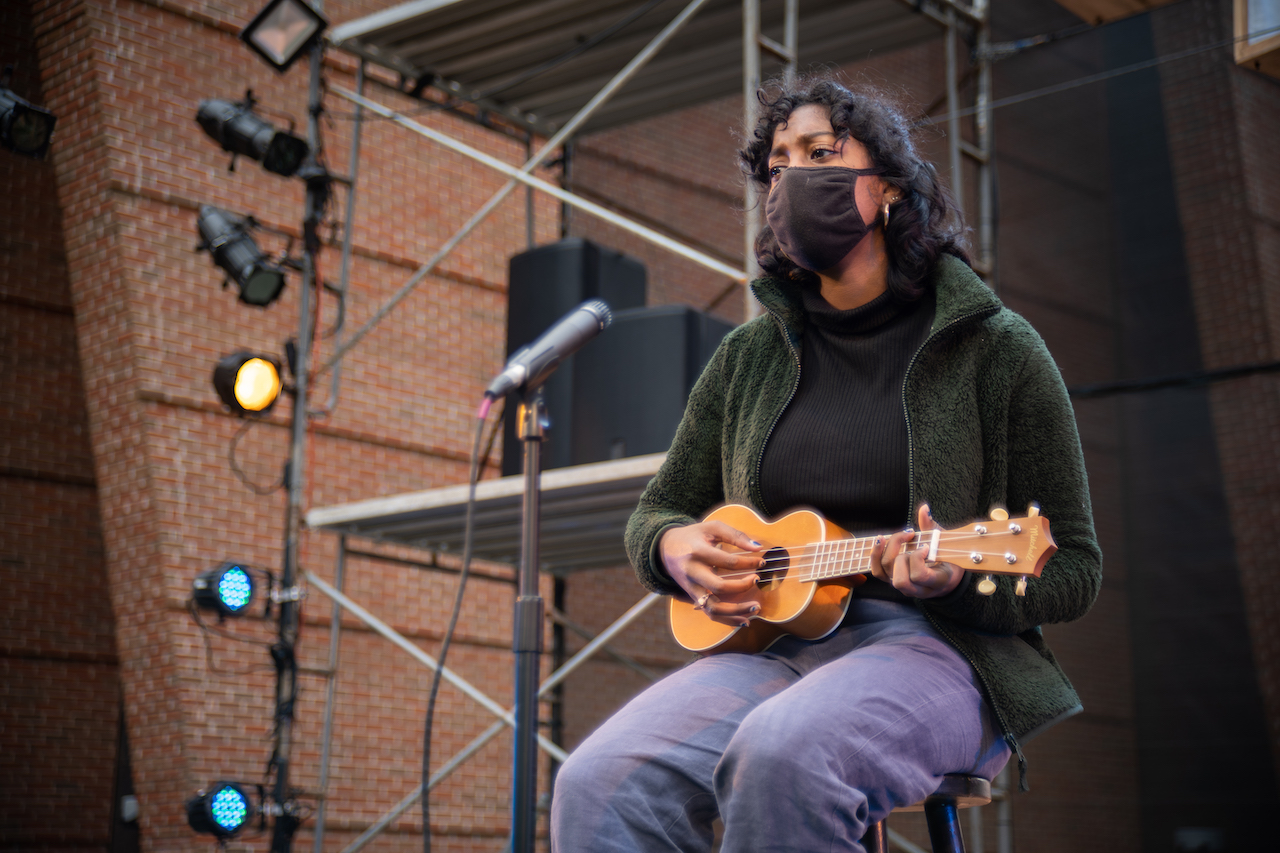
Photo by Coltrane Cho ’24
The light and love radiating off of the stage from all involved in the piece also extended through the Skidmore community, causing other SpringFest productions and on-campus events to postpone in order to stand in solidarity with Uplift and the BIPOC Affinity Night. This action set an example within the Theater department that truly nothing (even one’s own performance) is more important than having BIPOC spaces and voices on this campus.
Having Uplift and the BIPOC Affinity Night are steps in a better direction but steps with very small feet. Uplift demanded to be seen and heard, the bodies in the show demanded to be seen and heard, and it was a direct and blatant call-out to the Theater department and to Skidmore to not just talk about change and reform but to actually take action and make the change. In an Instagram take-over to promote the show, Lead Artist Will signs off with: “Supporting BIPOC projects is the first step towards us feeling like we actually belong at this predominantly white institution! …Please check your privilege, check out an anti-racist book and, most importantly, check up on your BIPOC friends!!!”
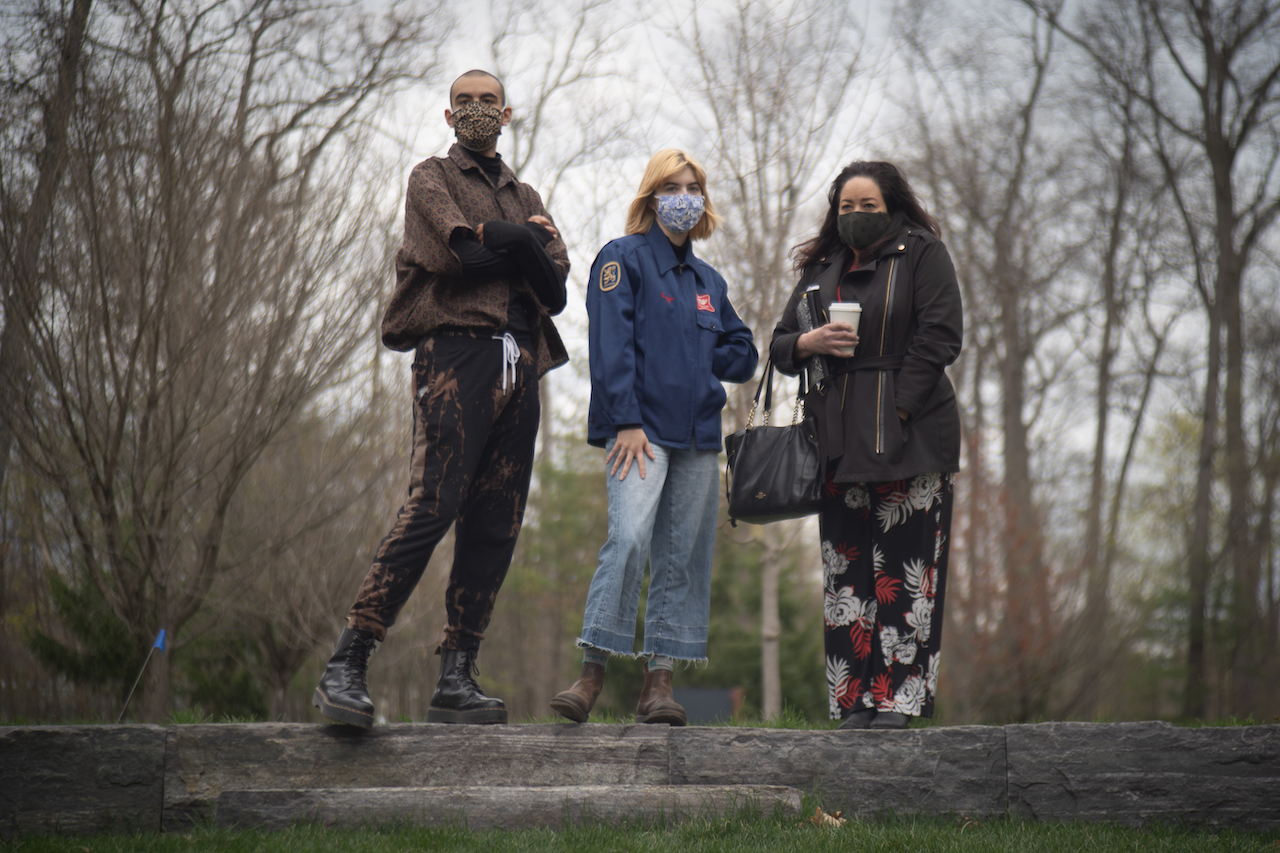
Photo by Coltrane Cho ’24
LEAD ARTISTS: Will Carter ‘23 and Anne-Sophie Vandenberk ‘23
DIRECTORS: Will Carter ‘23 and Anne-Sophie Vandenberk ‘23
SCENIC DESIGN: Wynn Lee ‘21
STAGE MANAGER: Dare Wedgeworth ‘23
CHOREOGRAPHER: Dare Wedgeworth ‘23 and Sarita Padukone ‘23
SOUND DESIGN: Braedon Quinlan ‘24
VIDEO TECHNICIAN: Braedon Quinlan ‘24
CAST: Isabella Kiely ’24, Arielle Lam ’24, Anesu Mukombiwa ’24, Sarita Padukone ’23, Annalise Sawit ’21, Jacob Smith ’24, Isha Smith-Ramakrishnan ’22, Red
___
The Chaparral
Covered by Gemma Siegler ‘22
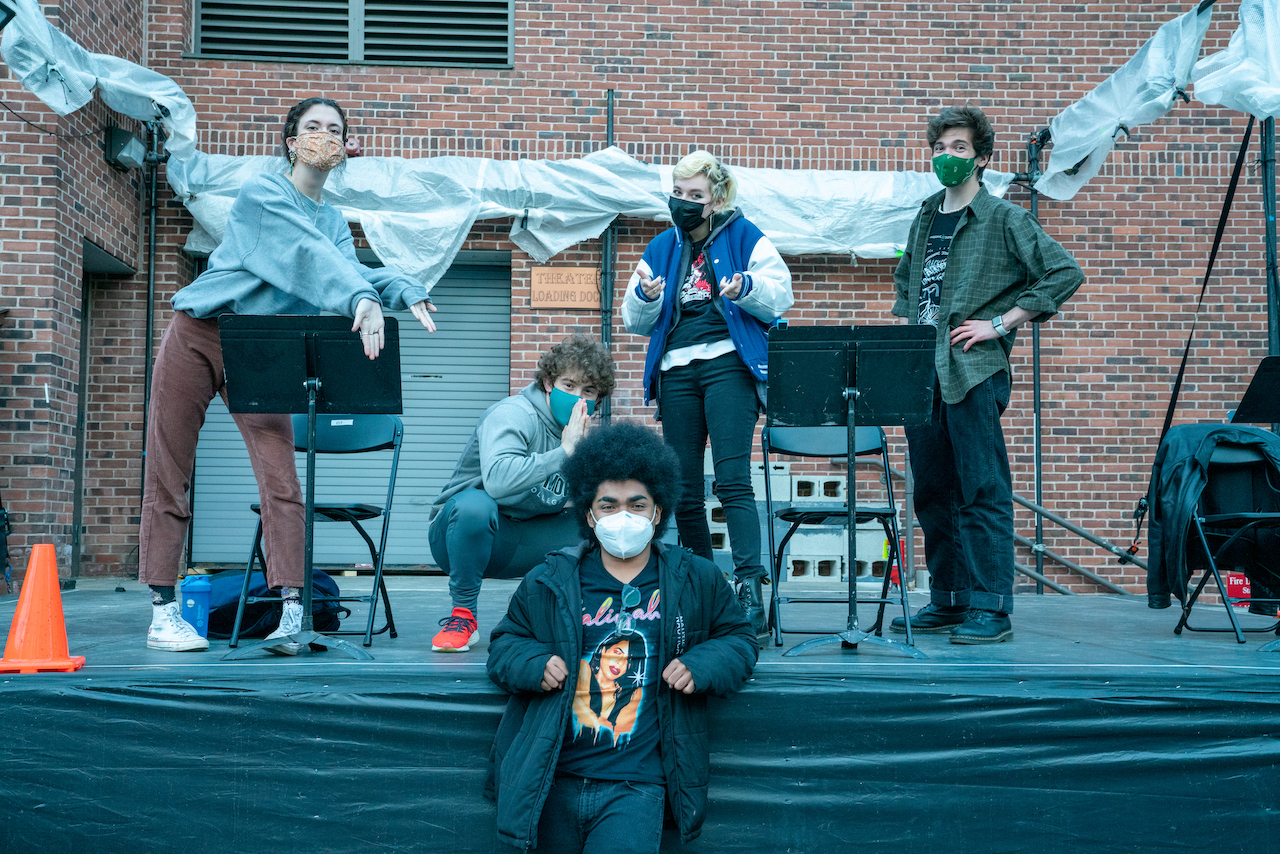
Photo by Wynn Lee ’21
The Chaparral, written and directed by Tatsu Rivera ‘22, was a hilariously funny and simultaneously heartwarming exploration into what it means to be queer today. The quippy humor of the scattered plant monologues, the sibling rivalry, and the importance of the play’s message made for a very well-rounded and exciting live theater experience.
When you take your seat at the loading dock, you are greeted by the energetic cast sitting in a line on the stage. Quickly, and through the impeccable quality of the writing and talent of the actors, we are transported to the interior of a car, driving through a desert-like expanse which is actually, pointed out repeatedly by Jean (Ely Lettow ’24) and later Fern (Jordan Gonzales ‘24), called a chaparral. Jean, accompanied by his younger sibling Alexis (Finn Lyon ‘23), drives through the chaparral with seemingly no end destination, making audiences wonder: what are they running (or driving) away from?
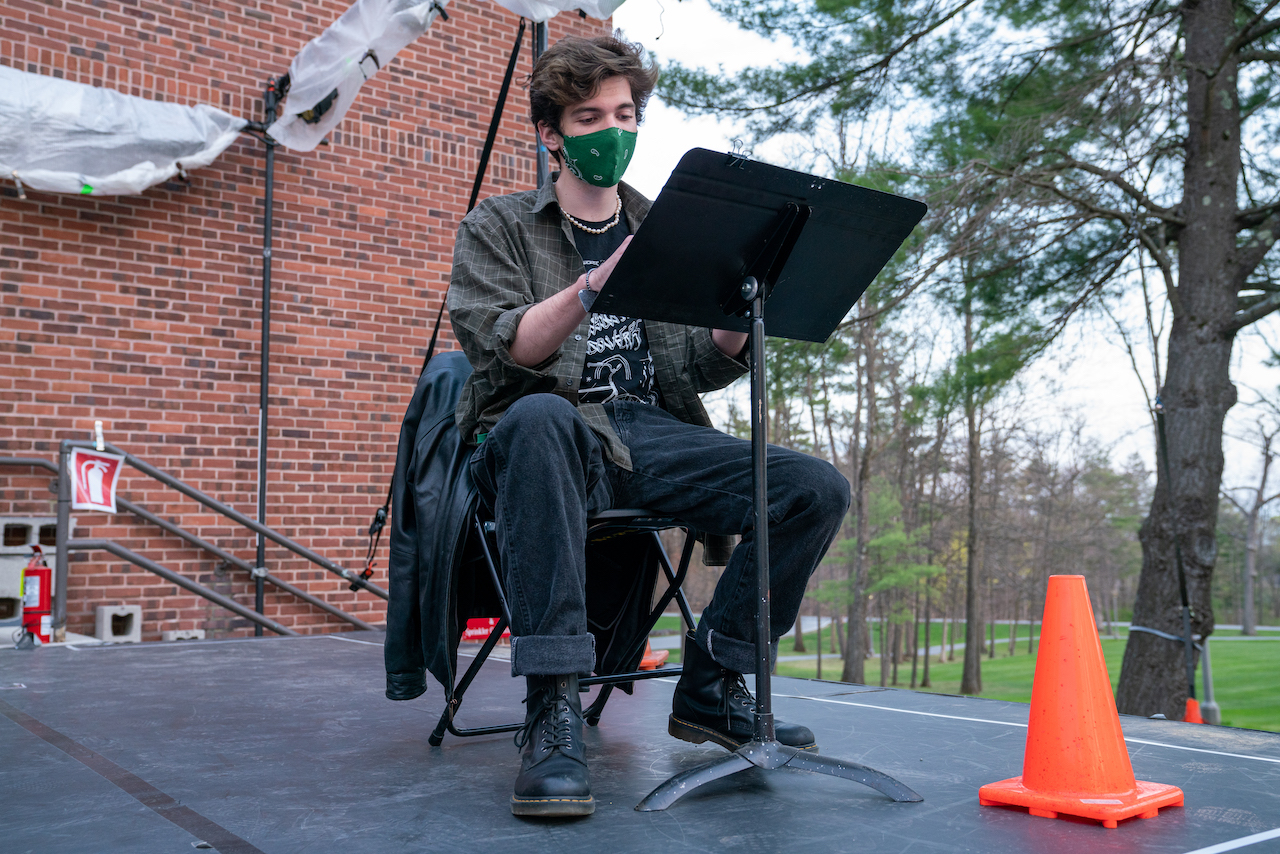
Photo by Wynn Lee ’21
The play begins with an extended moment of silence between Jean and Alexis, immediately establishing the close, comfortable relationship between the siblings. This is followed by a game, one supposedly made up by the siblings, in which they call out the names of the plants surrounding them. The rest of the scenes between the brothers are briefly interrupted by monologues spoken by these surrounding plants—specifically Plant, Tumbleweed, and Crabgrass (all played by Jordan Gonzales ‘24).
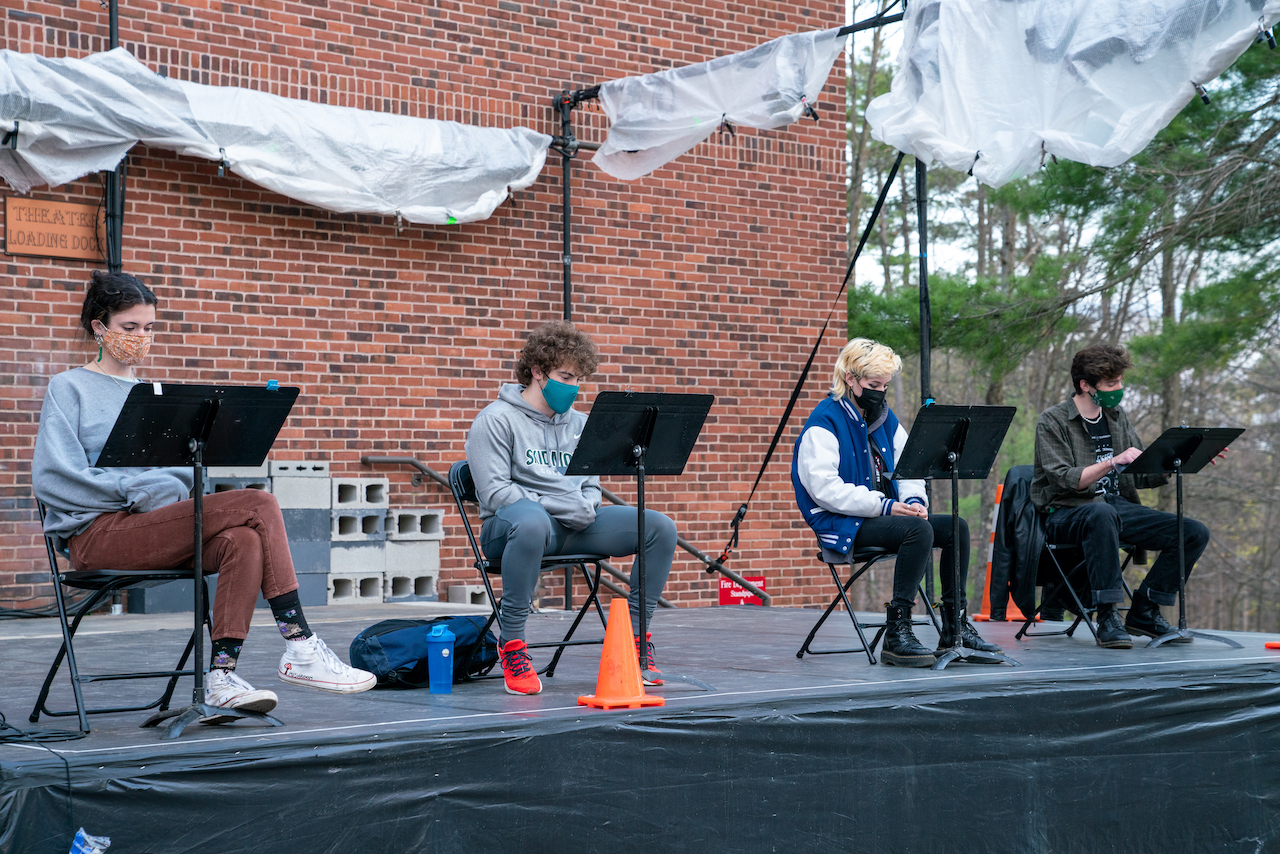
Photo by Wynn Lee ’21
When the character of Fern is introduced, however, the narrative complicates itself. Fern serves as a foil for the character of Jean, revealing the ways in which Jean has suppressed his true queer identity. Fern also helps audiences understand Alexis’s journey in discovering their gender identity and how that identity clashes with the beliefs of Alexis and Jean’s family. This expertly written character guides audiences along a journey that Alexis and Jean are perhaps too afraid or too ashamed to embark on themselves. Fern helps these siblings come to terms with their own true selves.
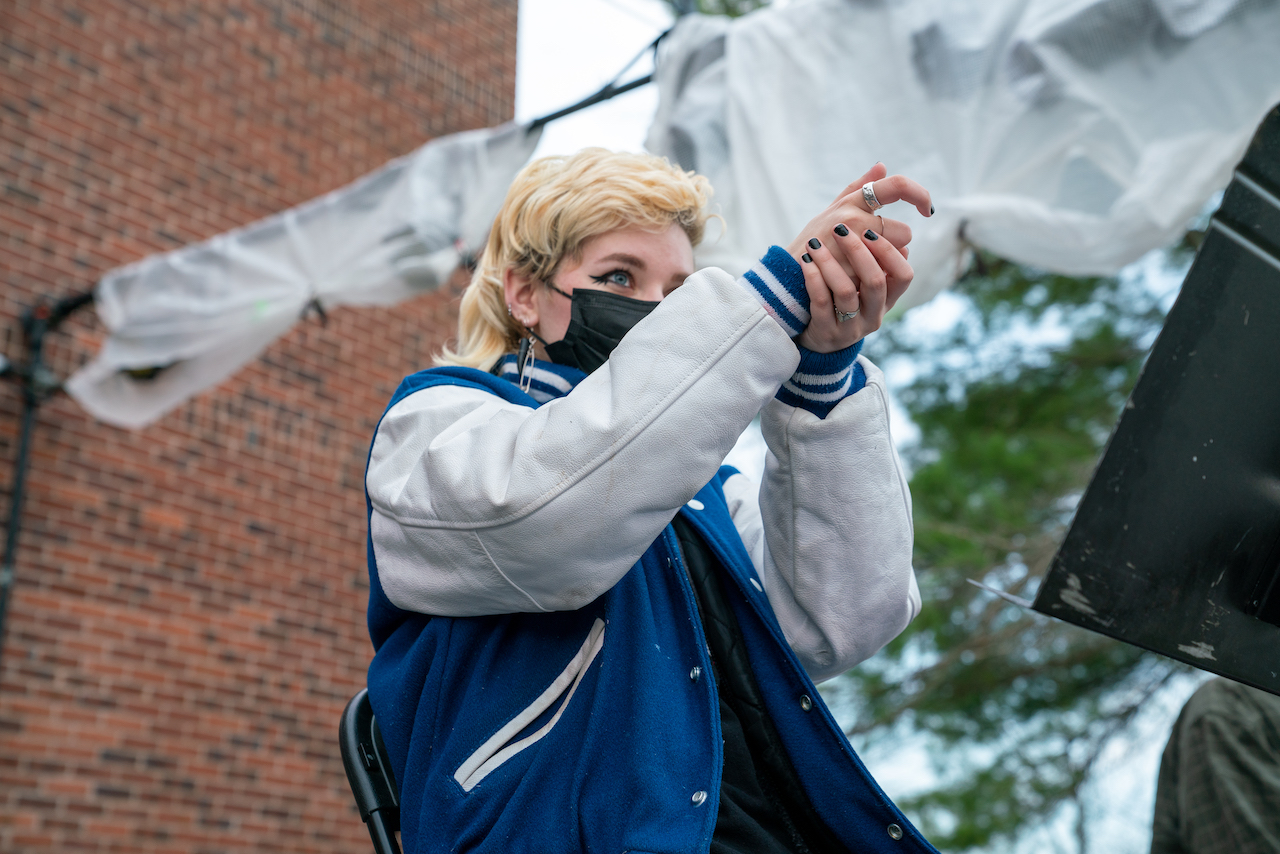
Photo by Wynn Lee ’21
The ending was one of my favorite parts, and a lovely moment from a playwriting, acting, and directing standpoint. All of the actors on the stage address the fourth wall like it’s a character, specifically the father of Jean and Alexis. Through this scene, we finally understand the goal of the sibling’s road trip: to run away from their abusive and manipulative father. Using the fourth wall to represent the father was a very smart choice as the father isn’t and shouldn’t be an embodied character; this would take away from the way this play centers themes of queerness.
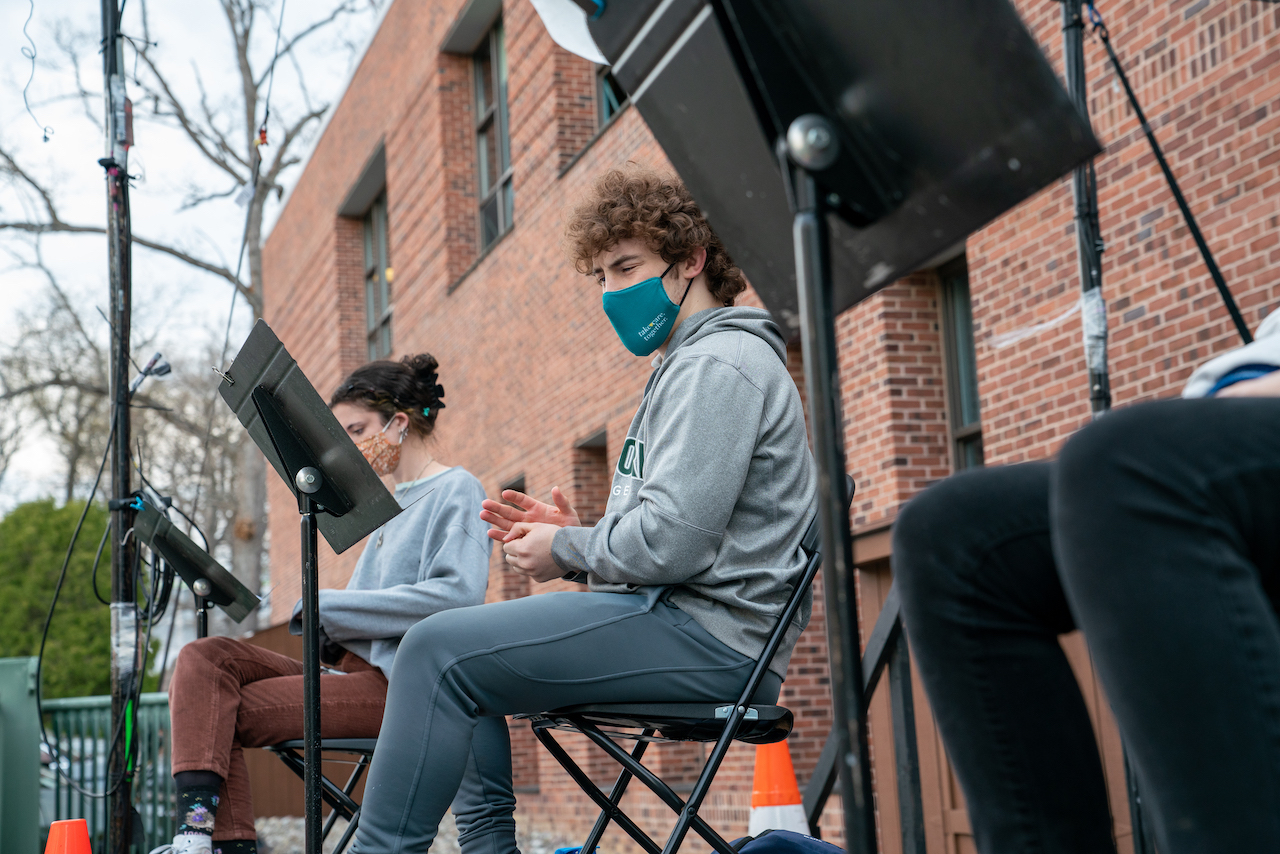
Photo by Wynn Lee ’21
Through Rivera’s expert work combining the hyper-realistic car scenes with a more surrealist approach to the plant asides, we experience both the real and the impossible throughout The Chaparral. This reading was a huge success on the part of everyone involved, and I’m sure everyone else who got to see this production would agree with me as, on both nights, the audience was laughing out loud and extremely connected to the material.
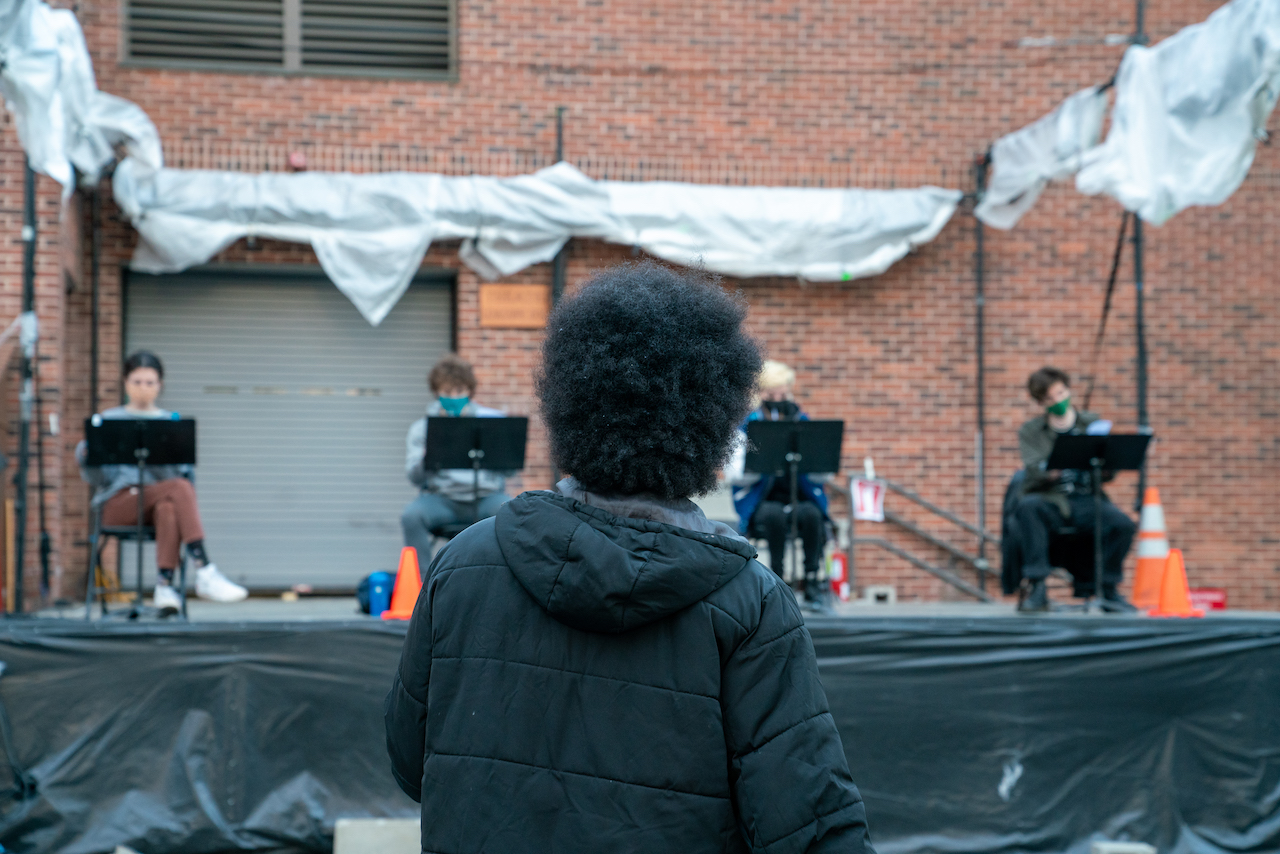
Photo by Wynn Lee ’21
LEAD ARTIST: Tatsu Rivera ‘22
DIRECTOR: Tatsu Rivera ‘22
PLAYWRIGHT: Tatsu Rivera ‘22
STAGE MANAGER: Char Biggs ‘21
CAST: Jordan Gonzales ‘24, Ely Lettow ‘24, Finn Lyon ‘23
___
Zombie Rain
Covered by Leah Cunningham ’23
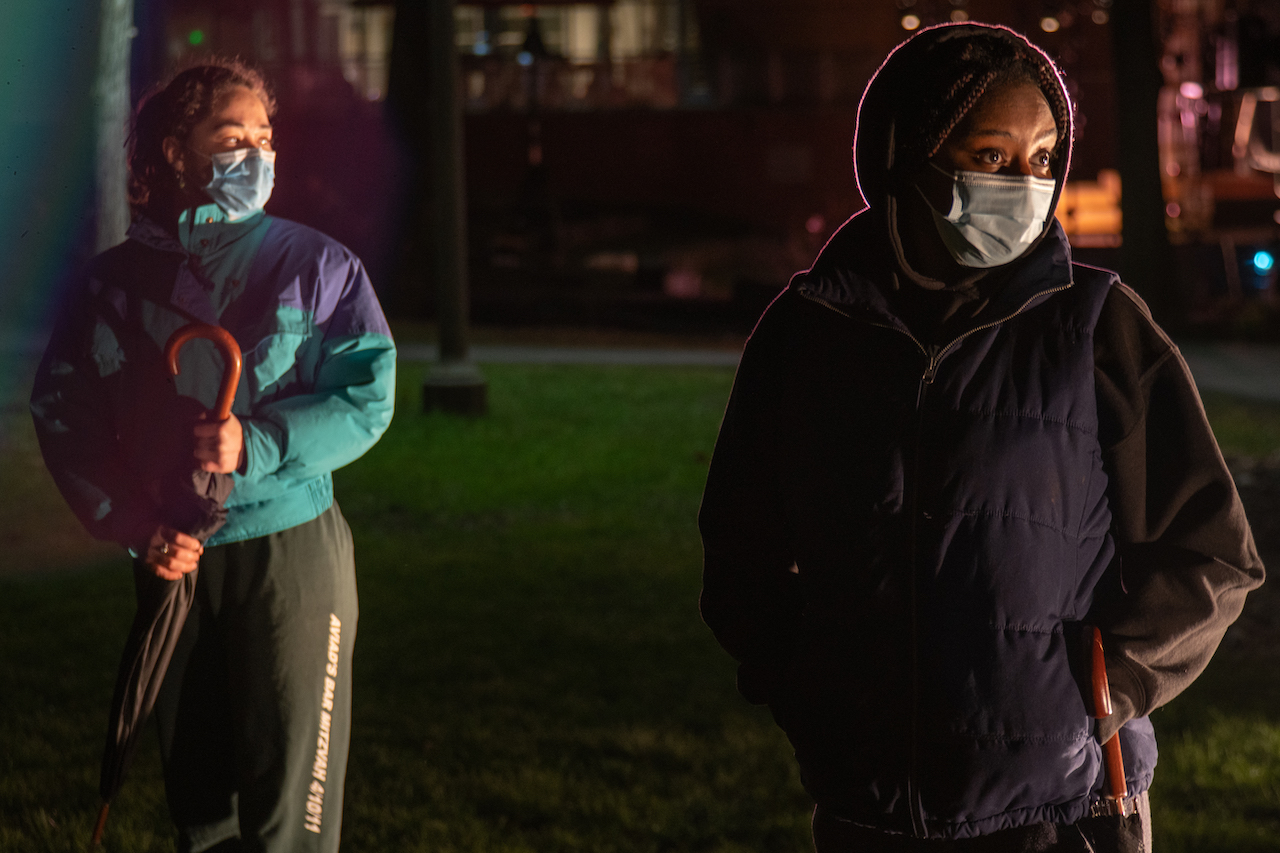
Photo by Coltrane Cho ’24
Zombie Rain is a devised production pioneered by Lead Artist and Director Jessie March ‘21. The show debuted on April 22nd and ran through April 23rd on the grass in front of the entrance to the Janet Kinghorn Bernhard Theater, the run time of each showing was approximately ten minutes. Live music played throughout the duration of the show, expertly executed by cellist Declan Morris ‘23. The premiere took place late at night and the illuminated stage area was enhanced by the contrast of the darkness of the surrounding atmosphere, courtesy of lighting designer Callan Daniel ‘23.
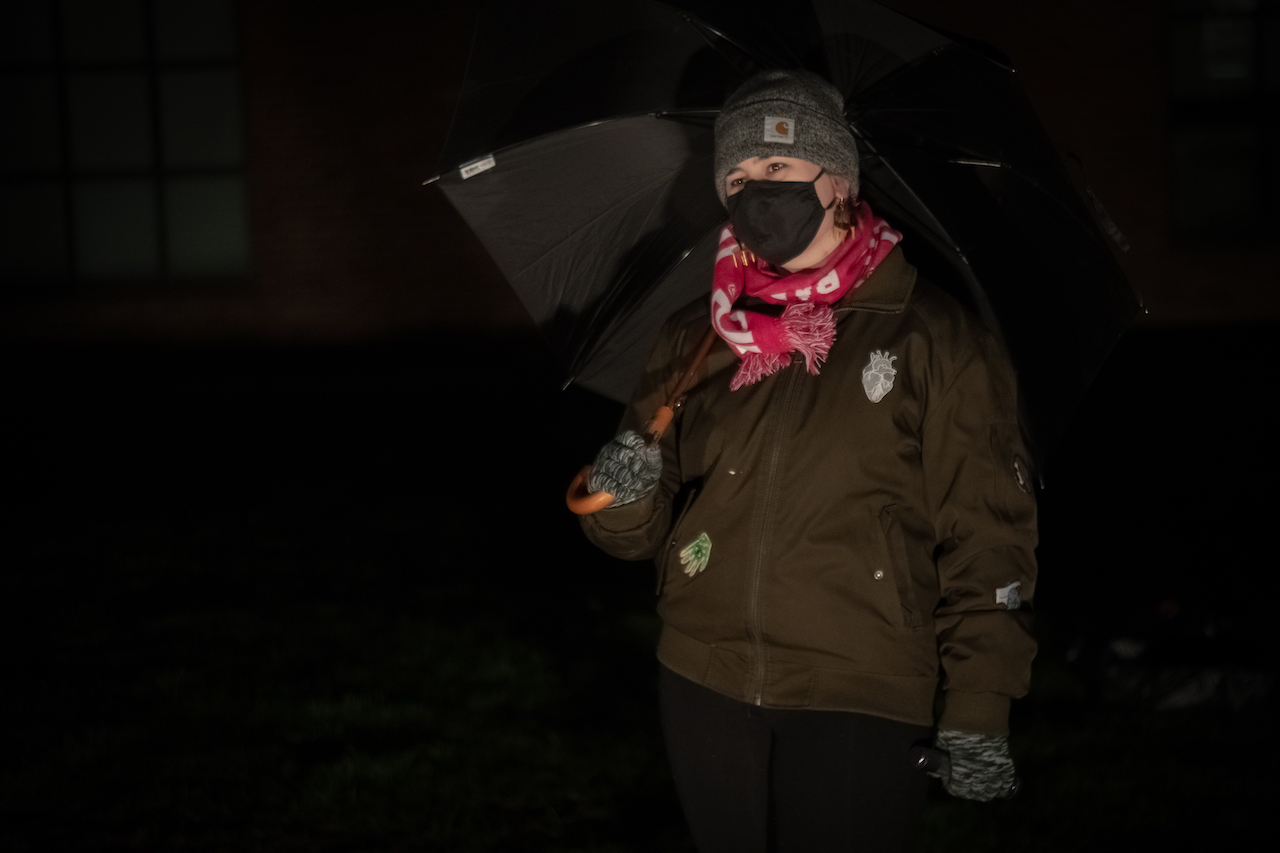
Photo by Coltrane Cho ’24
The show featured an ensemble of Olivia Berenson ‘24, Roman Cohen ‘22, Annie Cox ‘21, Maddie Evans ‘24, Chavon Patterson ‘24, and Yael R. Schoenbaum ‘21. The piece centered around the connections made and lost in a community struggling with forces outside of their control, a.k.a. the presence of and the transformations into zombies. The use of dark blazers and white masks to symbolize the zombies contrasted with the original costumes (designed by Finn Lyon ‘23). This further highlighted the zombies as an unknown and nameless entity.
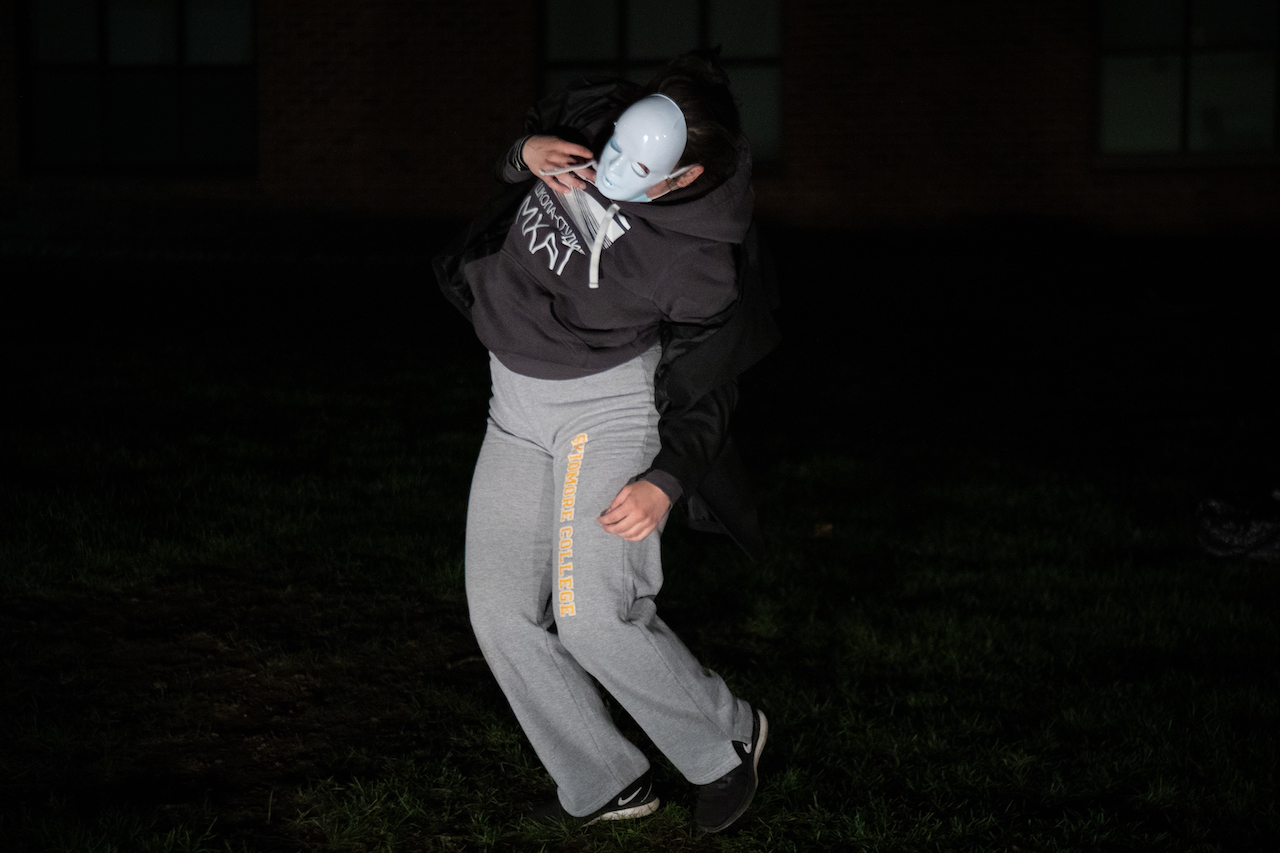
Photo by Coltrane Cho ’24
The actors begin as a part of a group and are suddenly picked off one by one from exposure to the mysterious elements, or from an interaction with their once-friends-turned-zombies. Eventually, the piece ends with the zombies consuming all but two of the remaining members, who are then chased off into the shadows. The performance demonstrated the devolution of a society with the introduction of an overwhelming event and how we choose to combat the uncertainty and unpredictability that comes with a loss of power.
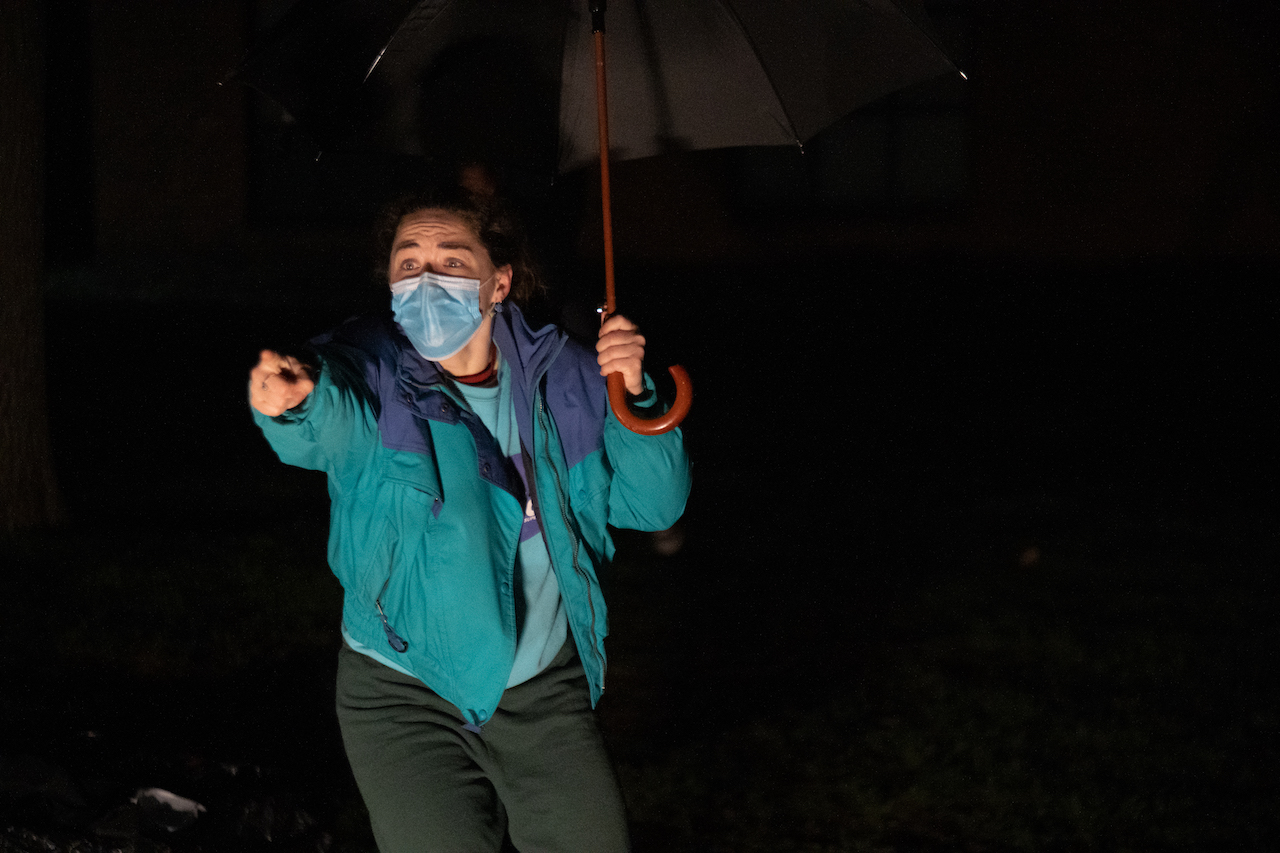
Photo by Coltrane Cho ’24
Due to COVID-19, the actors wore face masks throughout the show, but the story remained apparent despite the partial facial coverage. Additionally, the pandemic of course limits physical contact between actors, but this issue was combated with the impressive implementation of umbrellas and shadows. The umbrellas served multiple purposes throughout the show, symbolizing connection and community between actors when the handles hooked onto each other, as well as later protecting the characters from the infectious rain that transformed those exposed into zombies.
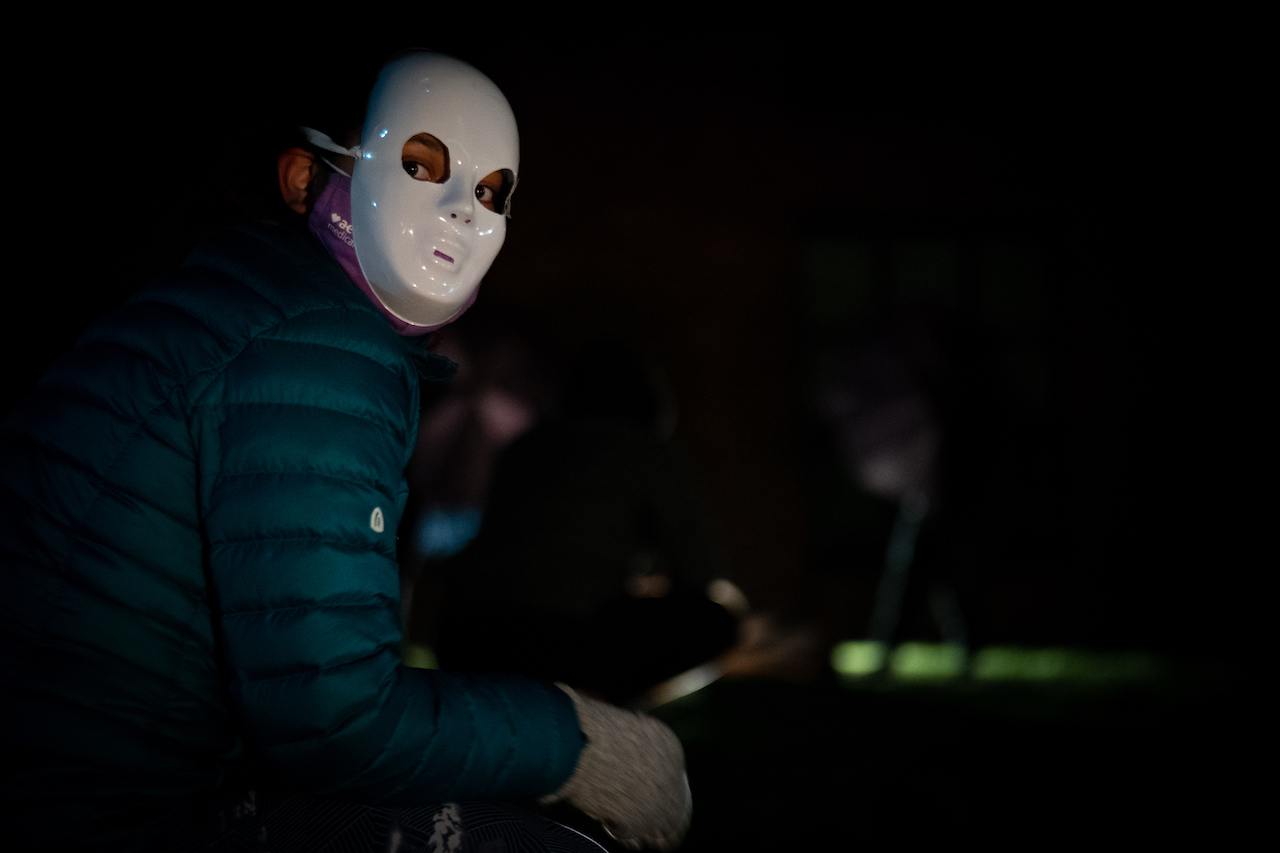
Photo by Coltrane Cho ’24
The piece showcased stylistic movement that emphasized the disparity between the zombies and the unafflicted – further contributing to the emotional portrayal of the plot. The Suzuki Method of Actor Training and practices of Butoh Dance Training influenced and inspired the execution of motion, as it supported the narrative and clearly depicted the story without depending on dialogue. Overall, Zombie Rain was a thrilling and thought-provoking production exhibiting intelligent use of technical elements melded with an engaging story.
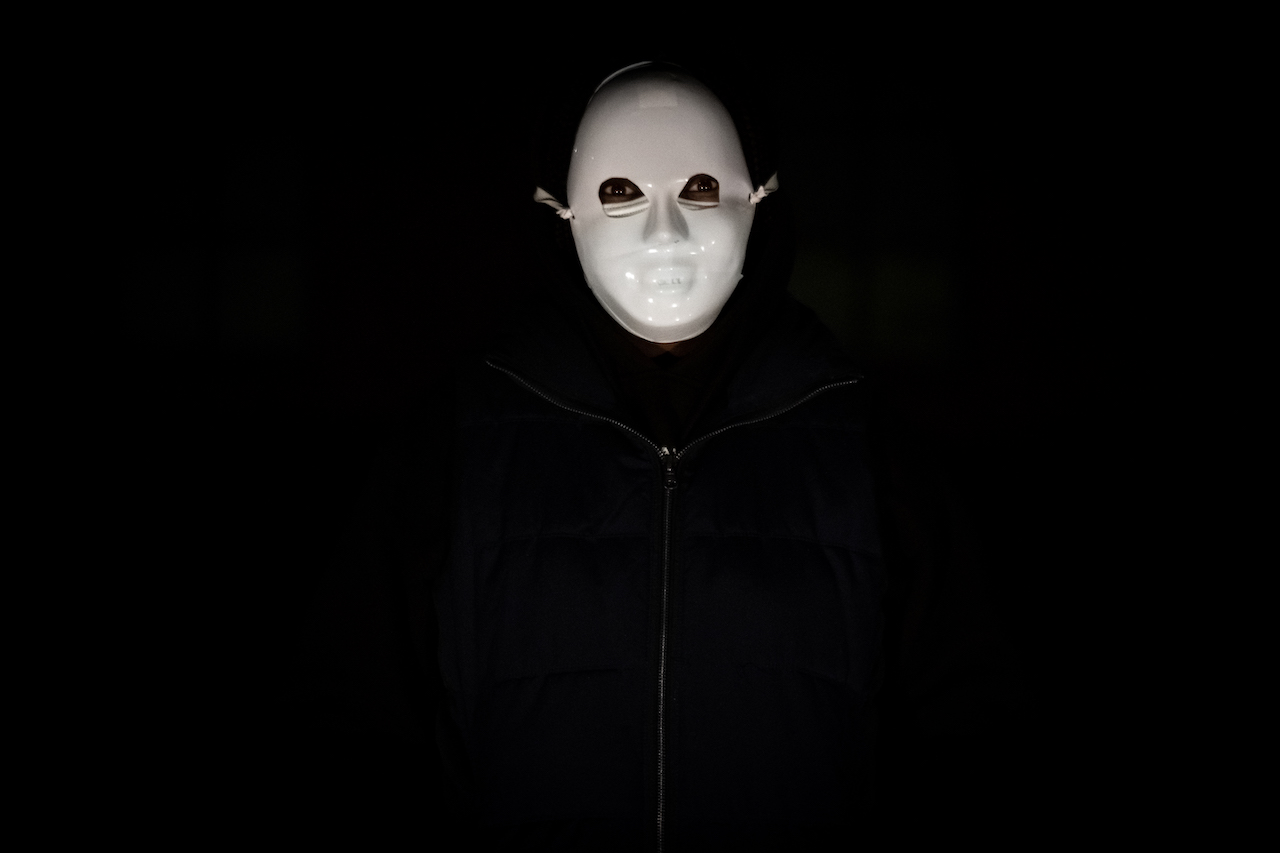
Photo by Coltrane Cho ’24
LEAD ARTIST: Jessie March ‘21
DIRECTOR: Jessie March ‘21
STAGE MANAGER: Noah Greenfield ‘24
LIGHTING DESIGNER: Callan Daniel ‘23
COSTUME DESIGNER: Finn Lyon ‘23
PROPS DESIGNER: Finn Lyon ‘23
CAST: Olivia Berenson ’24, Roman Cohen ’22, Annie Cox ’21, Maddie Evans ’24, Chavon Patterson ’24, Yael R. Schoenbaum ’21
CELLIST: Declan Morris ‘23
___
I Love XXX
Covered by Leah Cunningham ’23
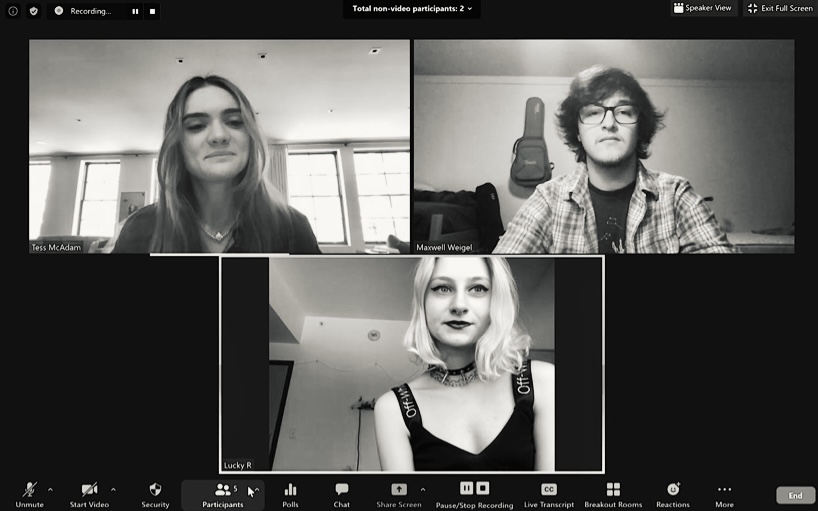
Screenshot courtesy of Sue Kessler
I Love XXX is a play written by Meng Jinghui, Huang Jingang, Wang Xiaoli and Shi Hang, translated by Dr. Claire Conceison, and directed by Cameron Jabs ‘21. The production debuted online at 2:30pm EST on April 24th via YouTube and the run time was around thirteen minutes. This piece was performed and executed entirely online and the actors performed collectively over Zoom. The footage was then edited into a larger video that featured overlapping images of cities, towns, lights, colors – a visual festival.
The ensemble consisted of Tess McAdam ‘23, Lucky Ricci ‘21, and Max Weigel ‘24. The production showcased a multi-media approach, as well as adapted dialogue to relate to the current geographic and political climate. At the top of the production, the actors attempted to read one line in unison – seemingly an easy task for three college students – but the interference of Zoom complications rendered it a nearly impossible task. With this moment, the director found some humor in the chaotic world of virtual theater. From that point forward, the audience was taken on a journey of a show that was an all-encompassing rollercoaster of emotion and meaning.
The piece was experimental in nature, and addressed the global and individual impacts of COVID-19, all told through statements of “I love…,” which fluctuated from wholesome to jarring throughout the show. With the repetition of “I love…” in mind, the actors’ inflection greater emphasized the feelings associated with their statements, resulting in a conflicting and profound emotional spectrum. While the actors operated remotely through Zoom, their dialogue was interspersed with imagery and sounds, creating a stimulating environment for deep-thinking and internal reflection. Cameron Jabs, Lead Artist and Director, added whimsical yet thought-provoking moments of fourth-wall-breaking, which further engaged with the audience and their interpretation of I Love XXX.
The show is flexible in nature, which allowed for the addition of personal messages referring to well-known places, restaurants, parks, buildings, and shops in the Skidmore College community as well as in the general Saratoga Springs community. The insertion and alternating statements regarding the pandemic, as well as other political concerns, added an immediacy to the production, as the topical elements grounded the show in the present day. The actors all managed to create moments of connection and interaction among each other, despite the limitations of online theater, and the production was in fact enhanced by the desire for storytelling and performance during this time.
The reiteration of the words “I love…” truly changed colors from statement to statement, as the tone with which the actor decided to read their line changed the meaning entirely, and each sentence was a journey unto itself. To conclude, I Love XXX is a thoughtful, deliberate portrayal of theater that encompasses the feelings of love, hate, frustration, happiness, joy, and sadness in a time where love is far from abundant. The adaptation is remarkably intelligent and emotionally intense while maintaining a prominent through-line of love for the art of theater.
DIRECTOR: Cameron Jabs ‘21
STAGE MANAGER: Leandro Bustos ‘23
CAST: Tess McAdam ’24, Lucky Ricci ’21, Max Weigel ’24
___
arch.I.tect
Covered by Maggie McGuire ‘24
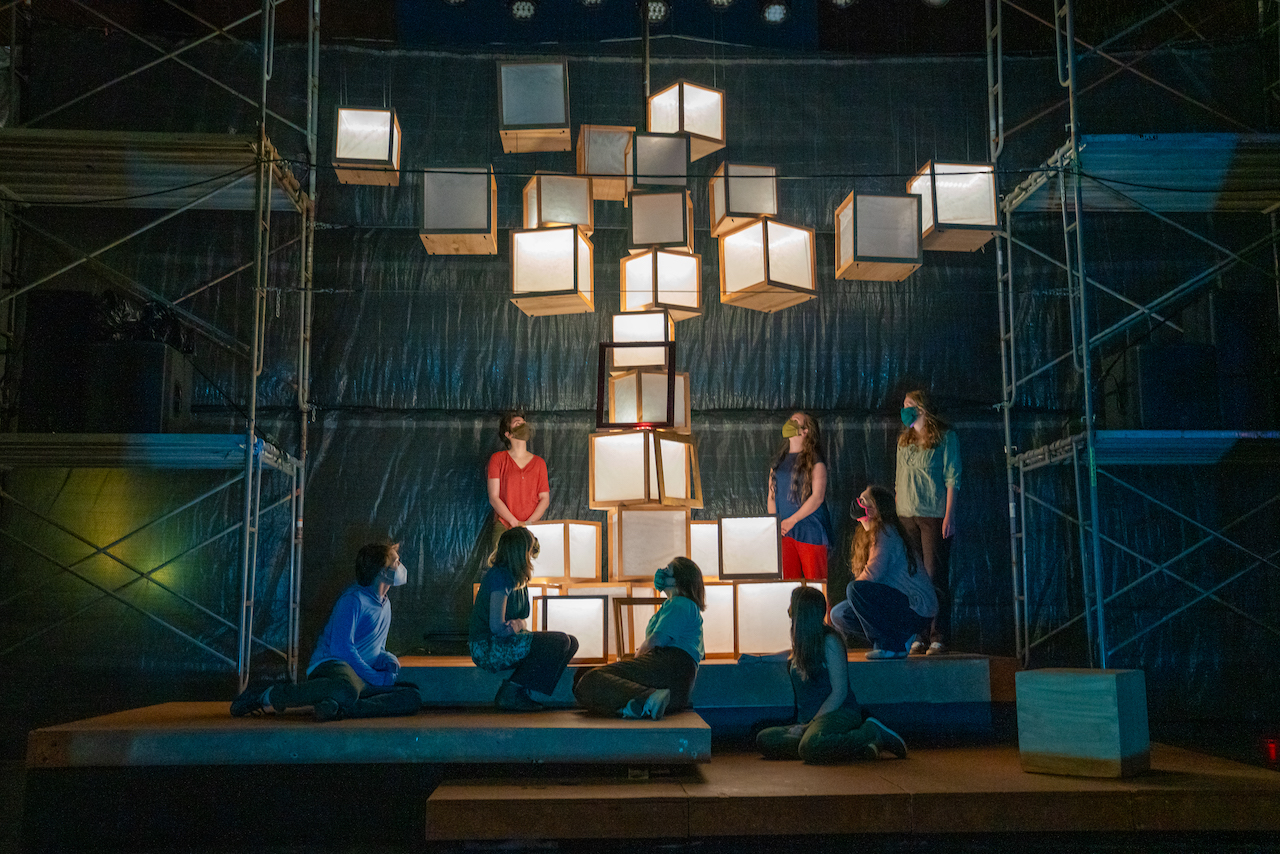
Photo by Wynn Lee ’21
The final show of the weekend was arch.I.tect, led by Marie Glotzbach. It was a devised piece, presented as a collection of different stories that reflect on what makes us ourselves. As an audience member, I can say that this message was abundantly clear, making arch.I.tect an enjoyable multimedia experience.
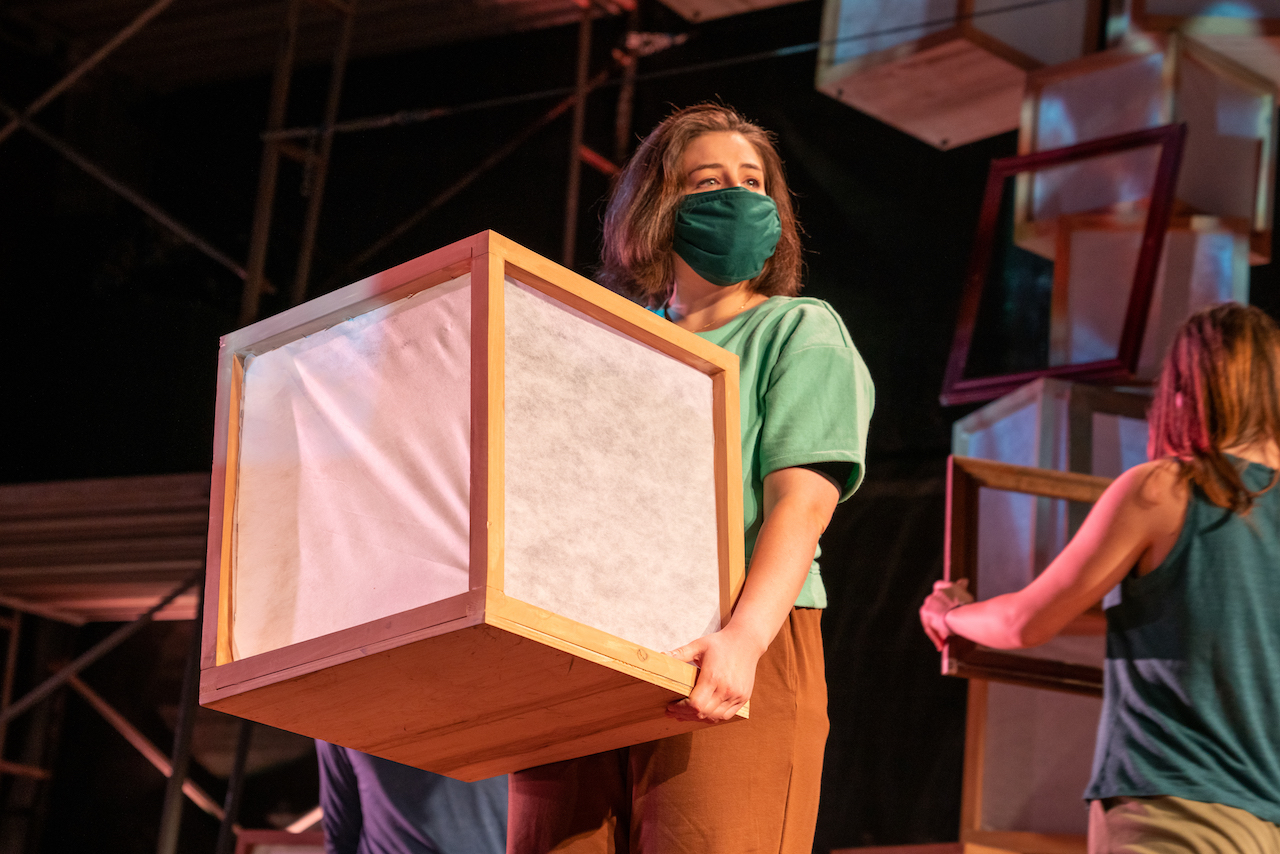
Photo by Wynn Lee ’21
The piece was broken into two parts, what I will call “arch.I.tect” and “arch.I.tect Encore.” The show itself was presented as a film, with the script coming from interviews with relatives and fellow Skidmore students as well as improvised and written material by the ensemble and production team themselves. I was actually presented with the opportunity to be interviewed for this show. I was asked questions about my life, ranging from where I was born to who I look up to the most to how I would define myself. Upon watching the film, I could see how the different interviews were combined into movement pieces, monologues, dances, b-roll shots, and more. arch.I.tect shows audience members that we all have different stories and we can tell those stories in a variety of ways.
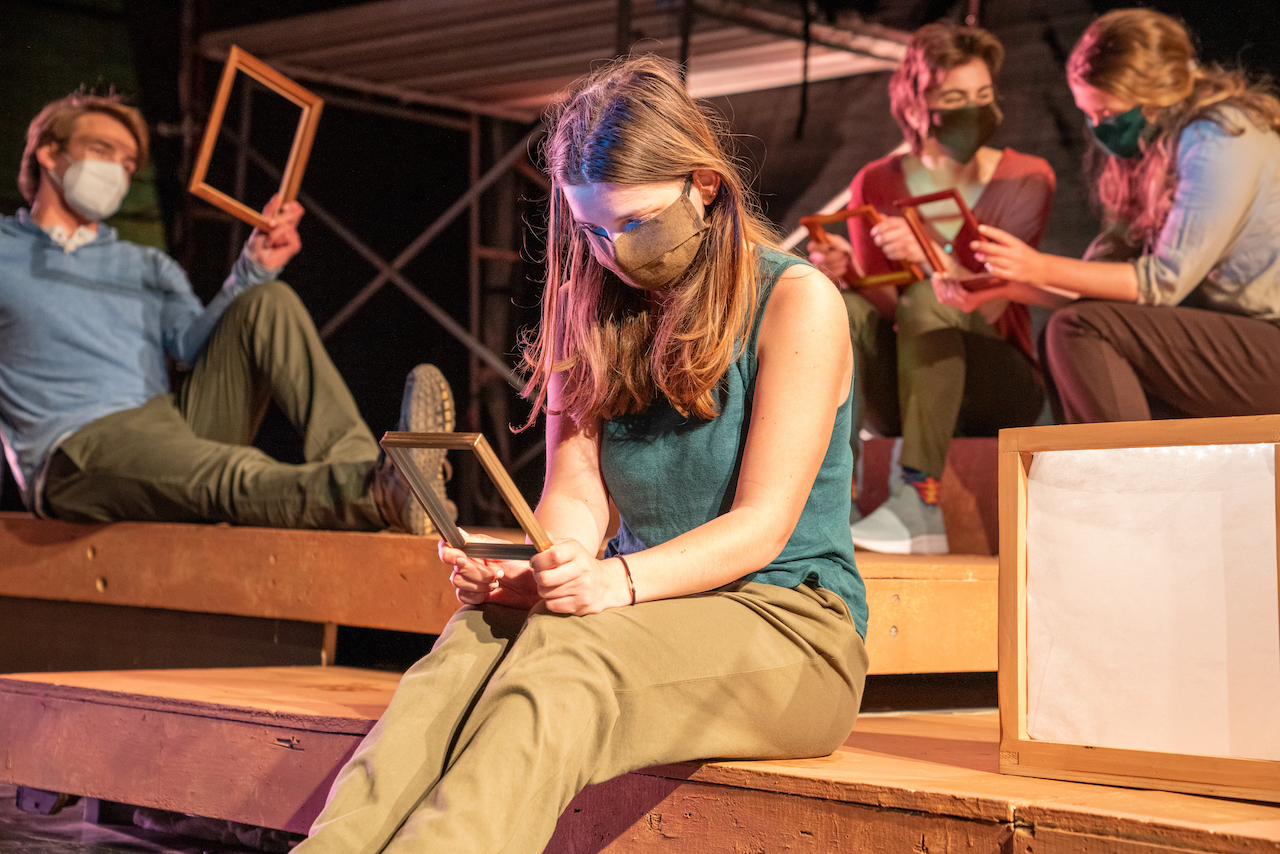
Photo by Wynn Lee ’21
The film began with a movement piece about being born. The ensemble moved about the trees outside of the JKB, bumping into each other, questioning what their purpose would be in life. From there, a few actors played a game, similar to freeze tag, using masks and picture frames to disguise themselves as they pointed at one another and laughed with glee.
The film had its comedic moments; from recreating the awkward tension of a middle school dance to the sounds of Nicki Minaj’s “Starships,” to Jonah Harrison ‘22 rolling around in a pile of his own headshots. The film had its serious moments as well; there were monologues about failure, death, loss, anxiety, and body dysmorphia. The balance of lighthearted moments and serious moments helped connect the audience with the stories being told. At certain points, I could see myself in the characters on the screen. arch.I.tect concluded with a beautiful dance, choreographed by Marin Asnes ‘21, to the song “Evergreen” by YEBBA.
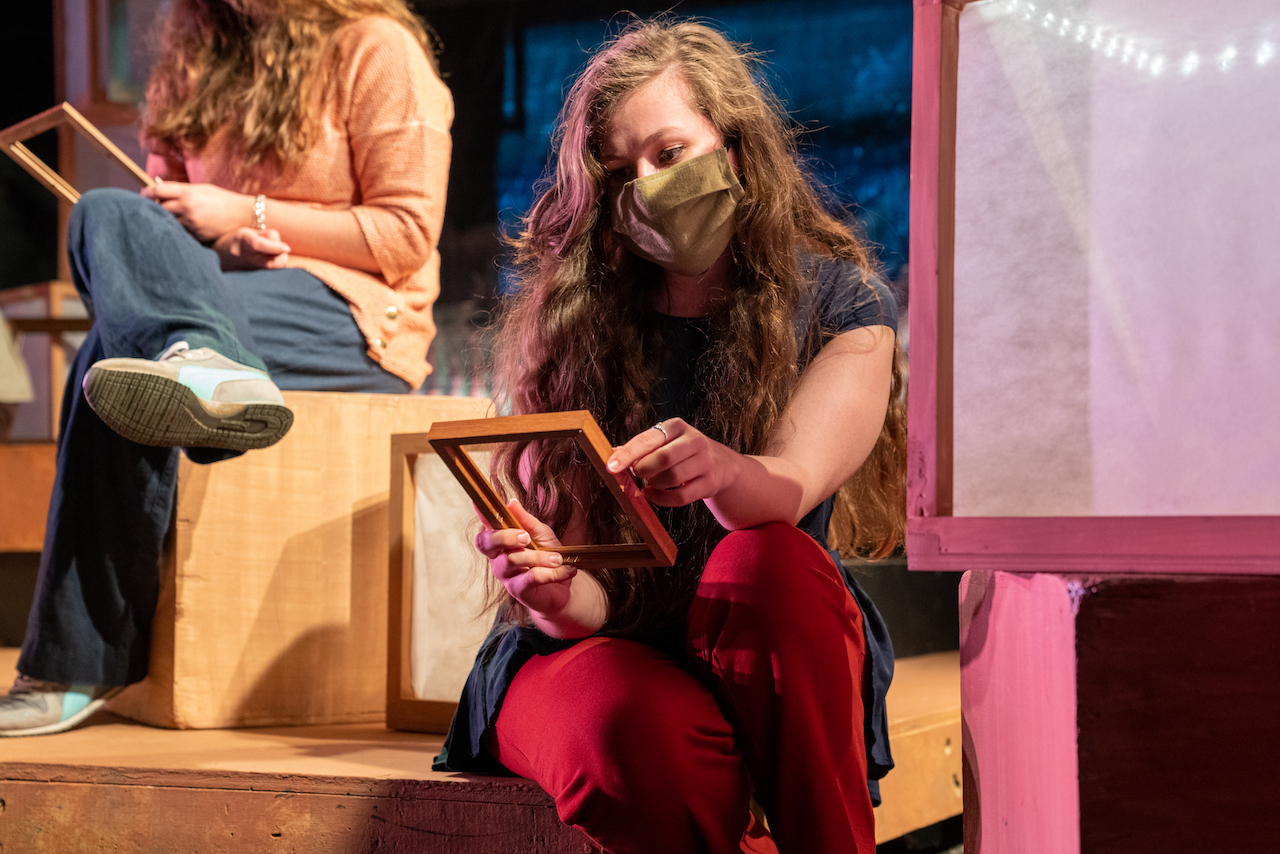
Photo by Wynn Lee ’21
Part two, or arch.I.tect Encore as I call it, was the definition of “the show must go on!” After the JKB tech crew removed the screen from the stage, assistant directors and ensemble members Liliana Mastroianni ‘22 and Amanda Hinge ‘21 told the audience that despite everything (meaning the inclement weather and the COVID level changes), they still wanted to showcase some of the moments from the film live and in person.
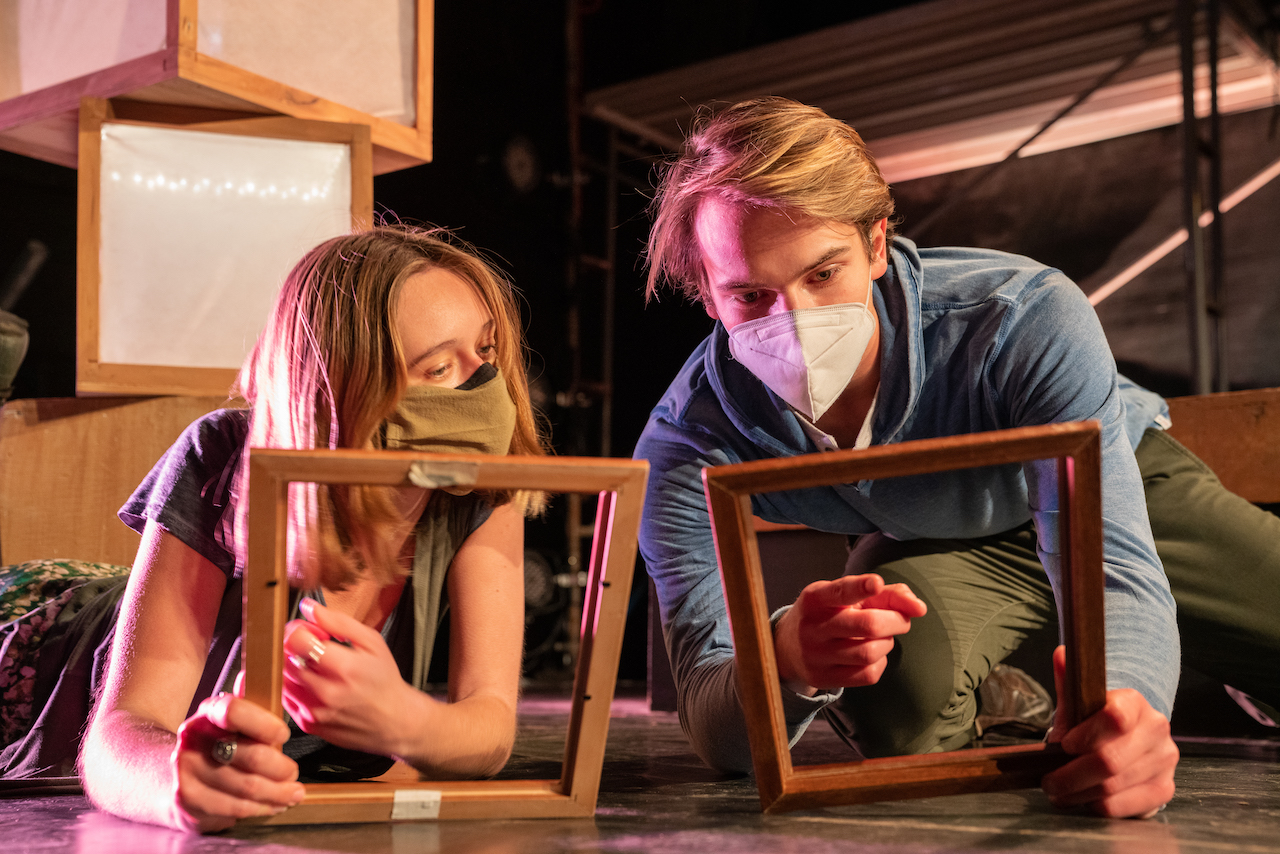
Photo by Wynn Lee ’21
A pivotal moment of arch.I.tect was when the cast gathered on stage carrying around different picture frames and boxes to the sounds of overlapped monologues about family history. These boxes covered the entire amphitheater stage and lit up when touched. Pictures of family members were projected onto the stage walls. Finally, the live show ended in an encore of the “Evergreen” dance.
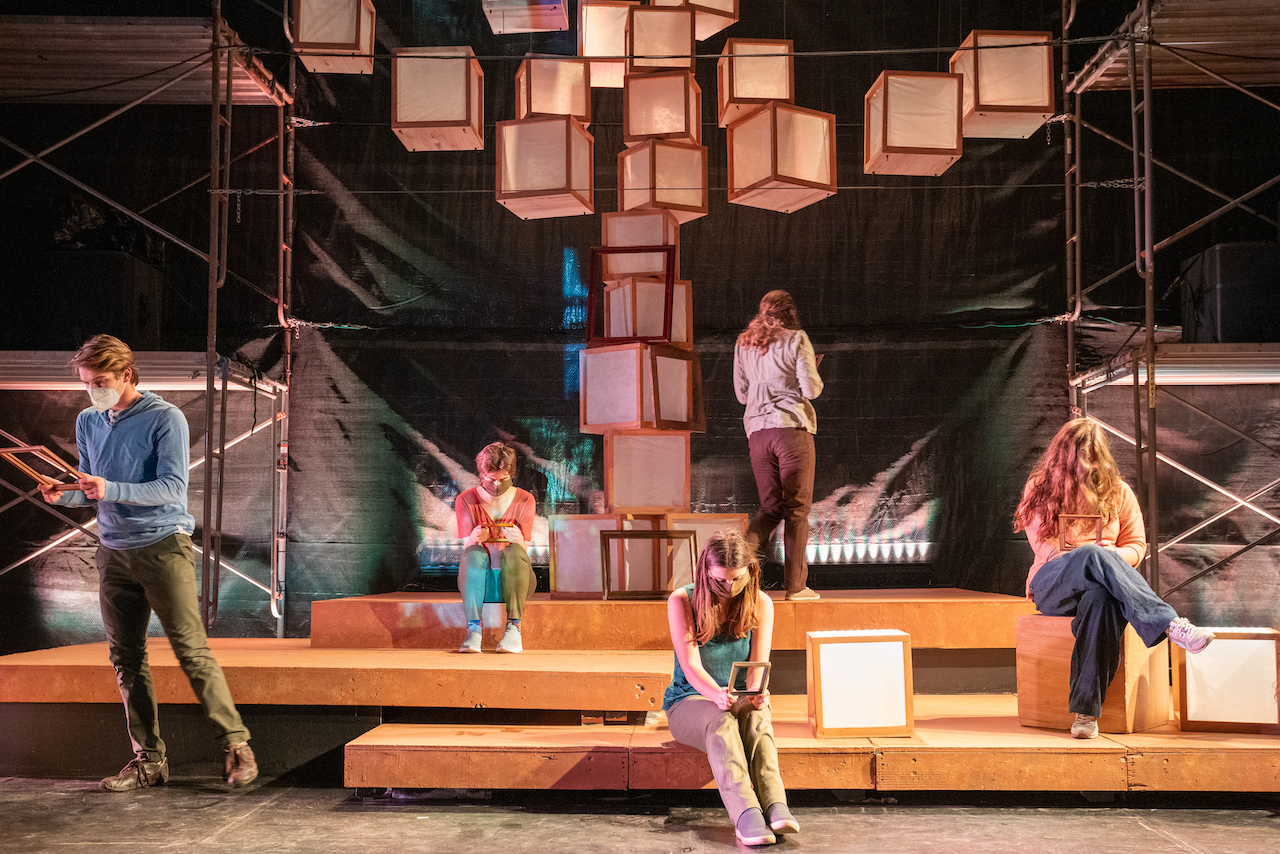
Photo by Wynn Lee ’21
Even though we’ve all had different life experiences, what arch.I.tect tells us is that we connect with others through the little similarities we share. At some point in our lives, we all have felt loss, happiness, anxiety, joyfulness – you name it. Although your experience will never be exactly the same as the person sitting next to you, these experiences we share make us human. We are the product of those who came before us, but we are also our own, individual people. We are defined by our choices, interests, and passions. We are remembered by those whose hearts we touched in our lifetime. All in all, arch.I.tect is a beautiful celebration of who we are and what we love.
arch.I.tect has a production website that you can check out here to learn more about the piece and its inception.
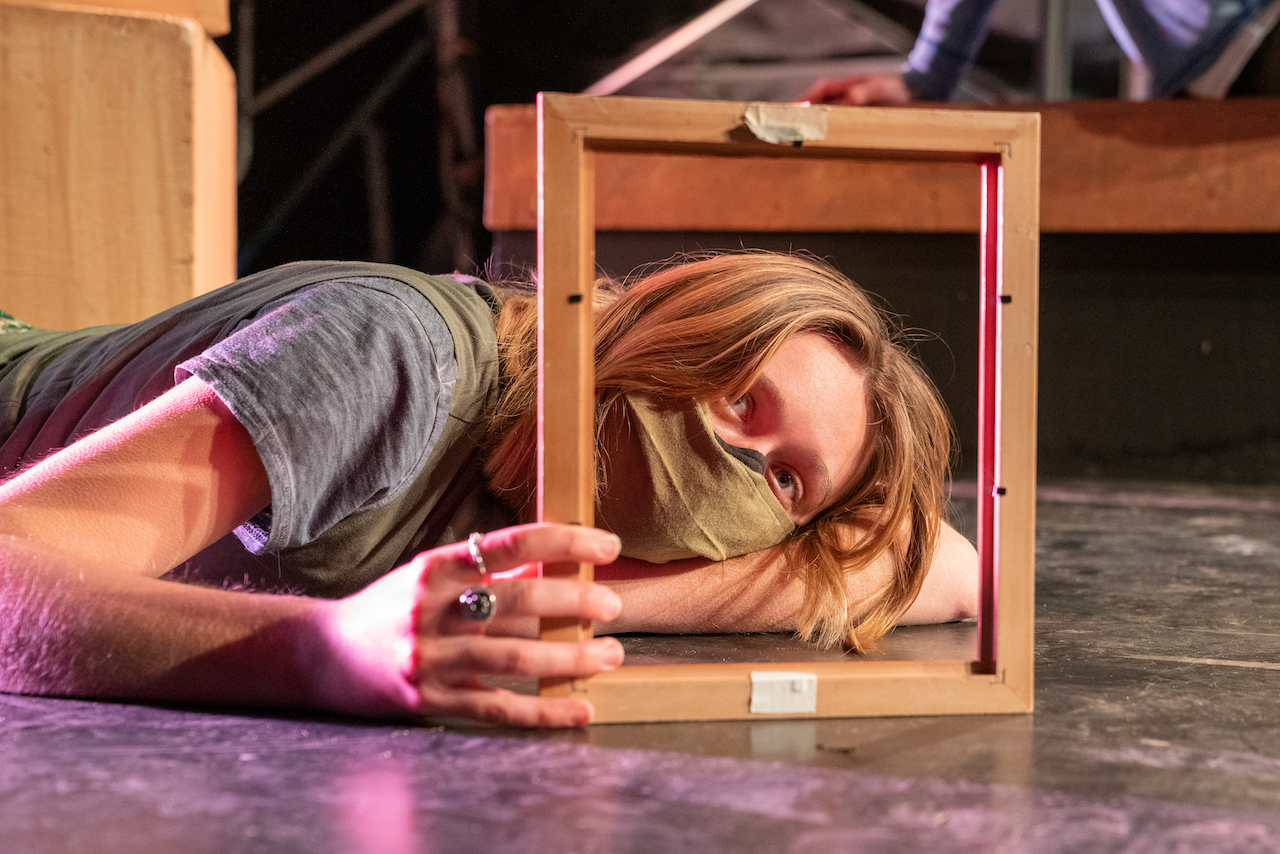
Photo by Wynn Lee ’21
LEAD COLLABORATION TEAM: Marin Asnes ‘21, Marie Glotzbach, Emily Hardy ‘21, Amanda Hinge ’21, Eliza Kuperschmid ‘21, Wynn Lee ’21, Liliana Mastroianni ’22
DIRECTOR: Marie Glotzbach
ASSISTANT DIRECTORS: Amanda Hinge ’21, Liliana Mastroianni ’22
DRAMATURG: Eliza Kuperschmid ‘21
STAGE MANAGER: Emily Hardy ‘21
ASSISTANT STAGE MANAGER: Nya Keith ‘23
MOVEMENT COORDINATOR: Marin Asnes ‘21
SCENIC DESIGN: Wynn Lee ’21
ASSISTANT SCENIC DESIGN: Isaac DeMarchi ‘23
PROPS DESIGN: Isaac DeMarchi ‘23
SOUND DESIGN: Emily Hardy ‘21
COSTUME DESIGNER: Patty Pawliczak
ASSISTANT COSTUME DESIGN: Kinzie Lane ‘21
LIGHTING DESIGN: Shelby Fairchild ‘21
PROJECTION DESIGN: Brendan Higham ’21
CAST: Anna Marie Fama ‘21, Jonah Harrison ’22, Hanna Nyberg ’22, Georgia Ossorguine ‘22, Sophie Pettit ’22, Emily Zeller ‘22
***
Eliza Kuperschmid ’21 and Gemma Siegler ’22 are Co-Editors-in-Chief of the Skidmore Theater Living Newsletter

